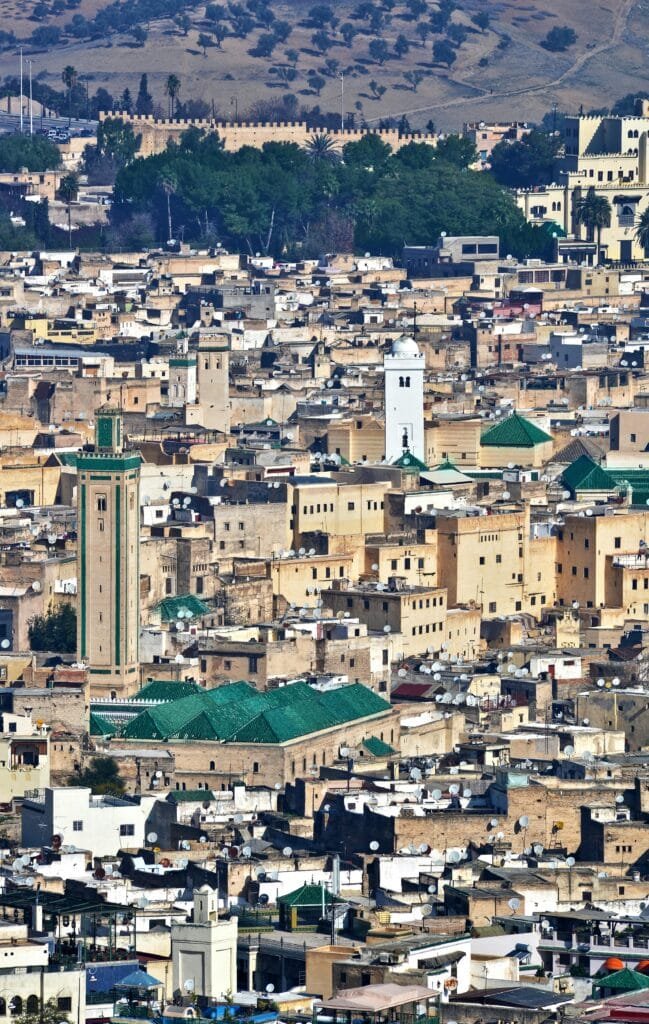The charming city of Fes is located in the bustling center of Morocco, where winding lanes entwine like strands of old silk. It is more than just a place on a map; it is a voyage through time, a glimmer of a glorious past, and a creatively pulsing present. Why does this historic imperial capital attract tourists from all over the world? The answer glistens in its imposing walls, in the fine details of its magnificent architecture, and in the scent of age-old crafts that have been handed down through the generations like precious gems. Join us as we reveal Fes’s hidden treasures, which captivate every traveler with their own charm. These include its historical sites that attest to its golden eras,
Exploring this city’s rich history is the best way to get the most out of your trip there. The old city is unique because it perfectly combines timeless traditional crafts with breathtaking historical landmarks, two treasures that tell the story of human history as a whole, not just Morocco. The city is one of the most famous travel destinations in the world because of this unique combination. We’ll walk you through the most well-known historical landmarks and traditional crafts in this post that you simply must see. We advise you to explore at least 80% of these wonders in order to fully enjoy your trip and make enduring memories, as each one provides a distinct window into the heart of the City.
The Most Iconic Landmarks of the City
1. Al-Qarawiyyin University and Mosque
Imagine standing within the embrace of a monument that has witnessed over a thousand years of history! Founded in 859 AD, Al-Qarawiyyin is the oldest university still running today. It’s more than just an ancient school; it holds a special place in history as a lasting educational institution. It is a living symbol of Morocco’s strong ties to knowledge and spirituality. It offers a unique glimpse into the history of human thought.
When you enter the ancient courtyard and explore the decorated prayer halls, it feels like a trip back in time. In this place, where minds meet and knowledge has flowed for centuries, you can feel history’s pulse. Here, you connect with Fes’s true intellectual and cultural heart.
Don’t miss the extraordinary opportunity to visit this landmark. It’s not just a tour stop. It’s a rich experience. You’ll embark on a deep spiritual and intellectual journey. You’ll connect with the story of an ancient civilization that still lights the way to knowledge today. It is truly a gem that every traveler seeking to understand the essence of Fes must discover.
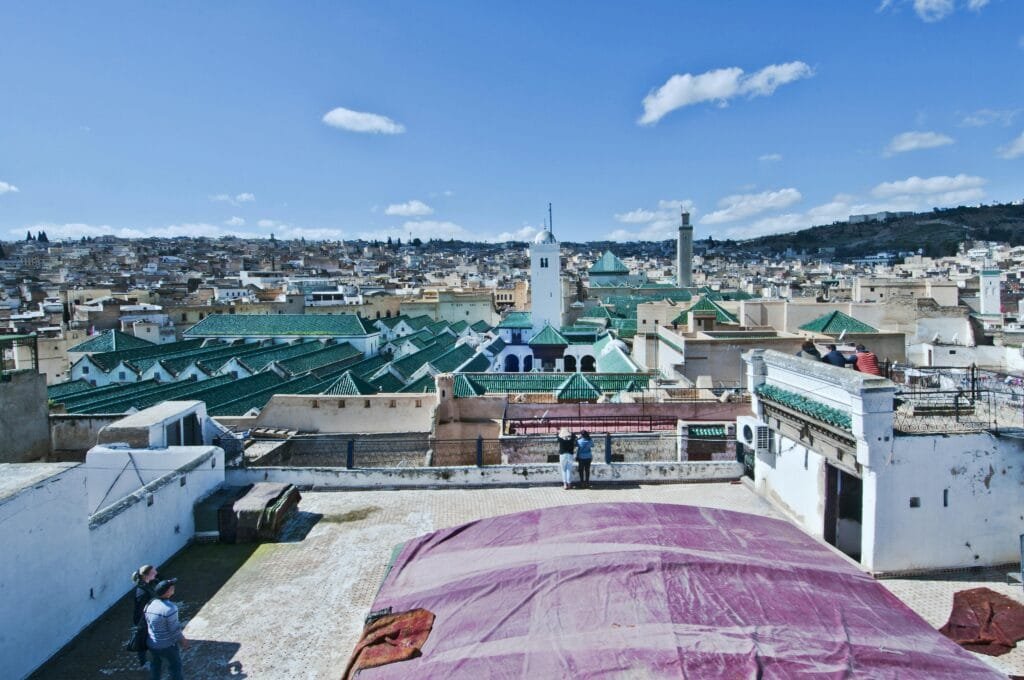
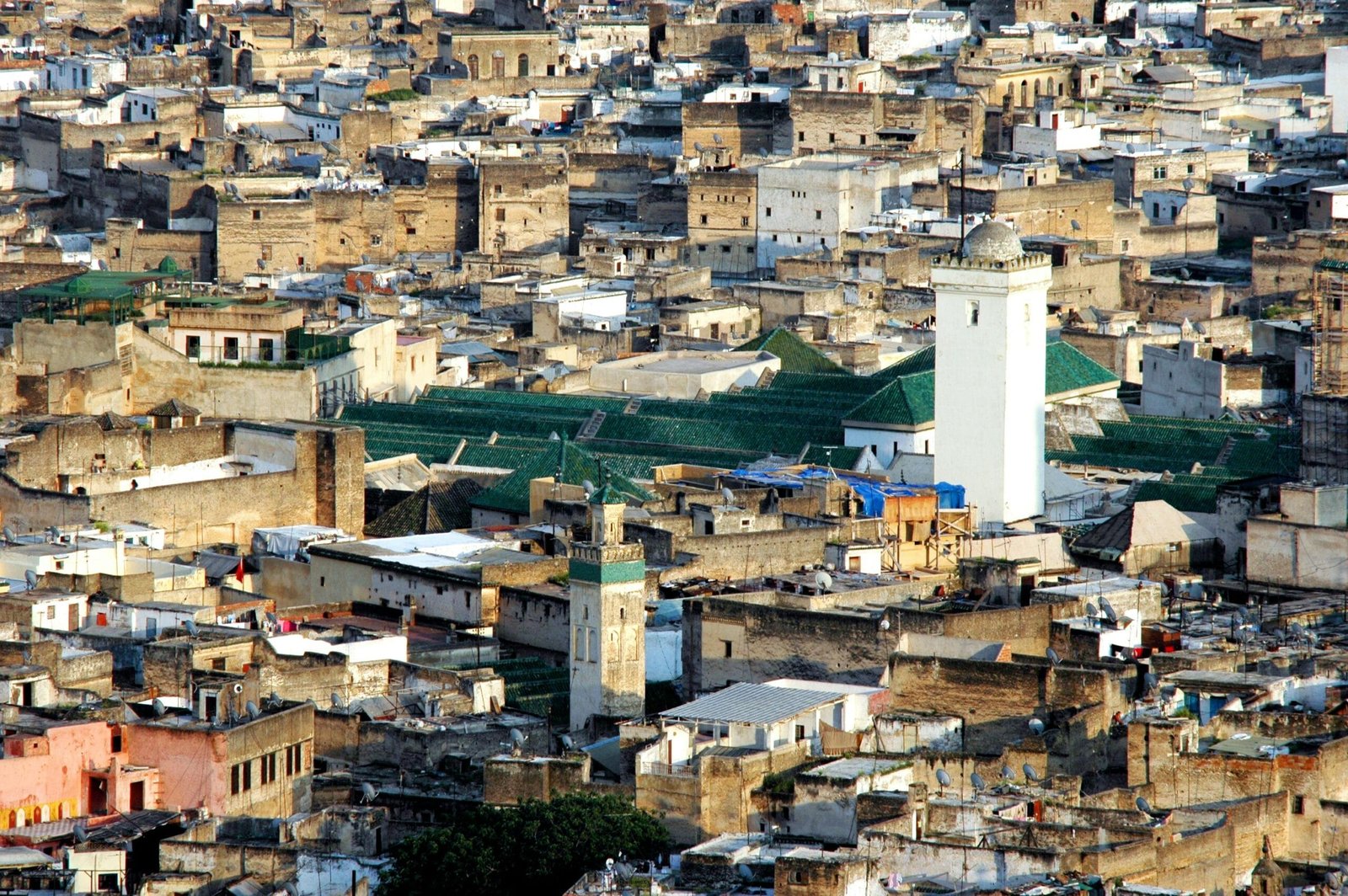

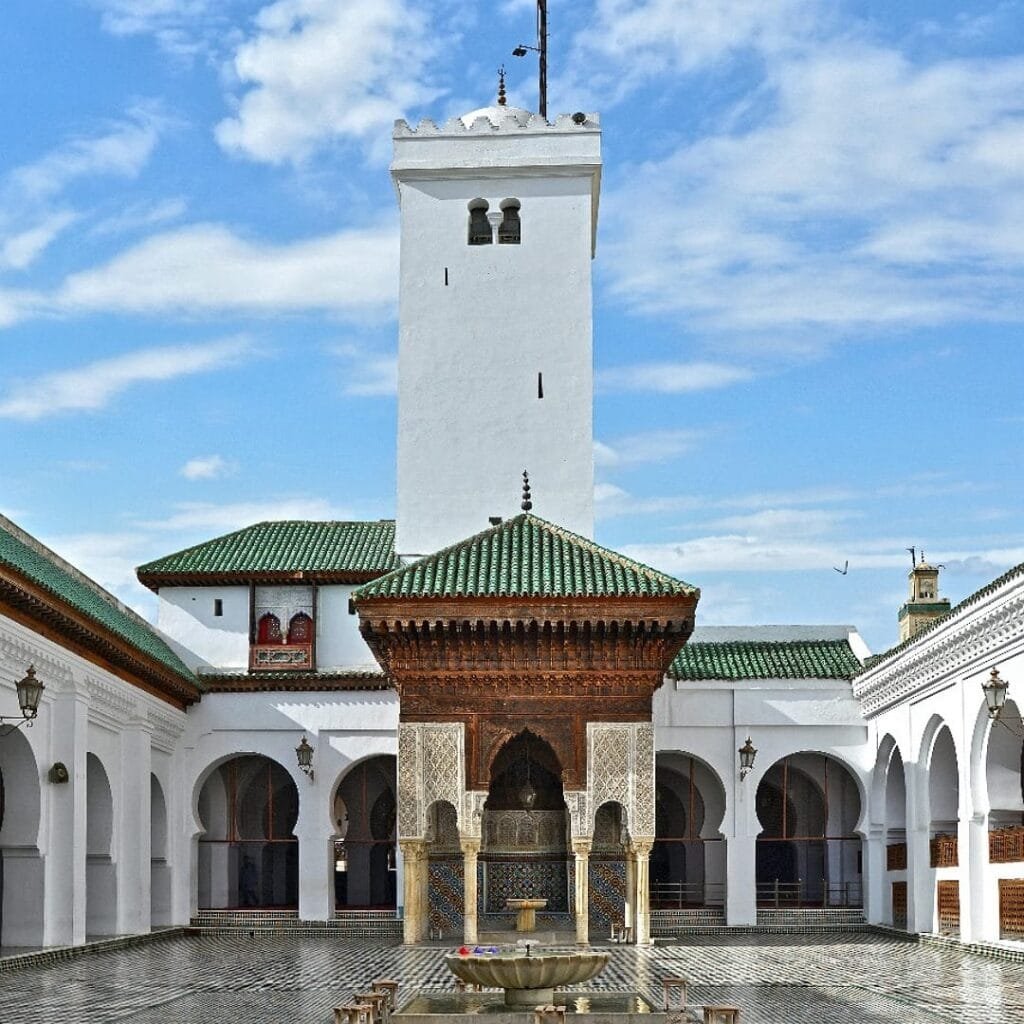

2. Mausoleum of Moulay Idriss II
In the lively old city, where history and spirituality meet, stands the Mausoleum of Moulay Idriss II. It is one of the most respected sites in Fes. Moulay Idriss II founded this ancient city. He is seen as the spiritual father of Morocco and a key figure in its history and religious identity.
Tradition says non-Muslims can’t enter the shrine. Still, its beautiful exterior and the surrounding atmosphere show great splendor and devotion. They reflect the true essence of traditional Moroccan artistry. You can appreciate the intricate carvings, lovely designs, and soothing colors that bring peace and respect.
Walking around the square by the mausoleum is a great way to feel the essence of Fes. You can see how much respect locals have for their history and heritage. You will see acts of worship and devotion. You will also hear whispers of prayers that show how much this holy figure means to Moroccans.
Visiting the Mausoleum of Moulay Idriss II is more than a quick stop. It offers a glimpse into the city’s deep spirituality. You can truly feel the pulse of Fes, founded by this great man who built its glory. It lifts the spirit and enhances our grasp of Morocco’s history and ancient culture. Do not hesitate to dedicate time to exploring this sacred and inspiring site.


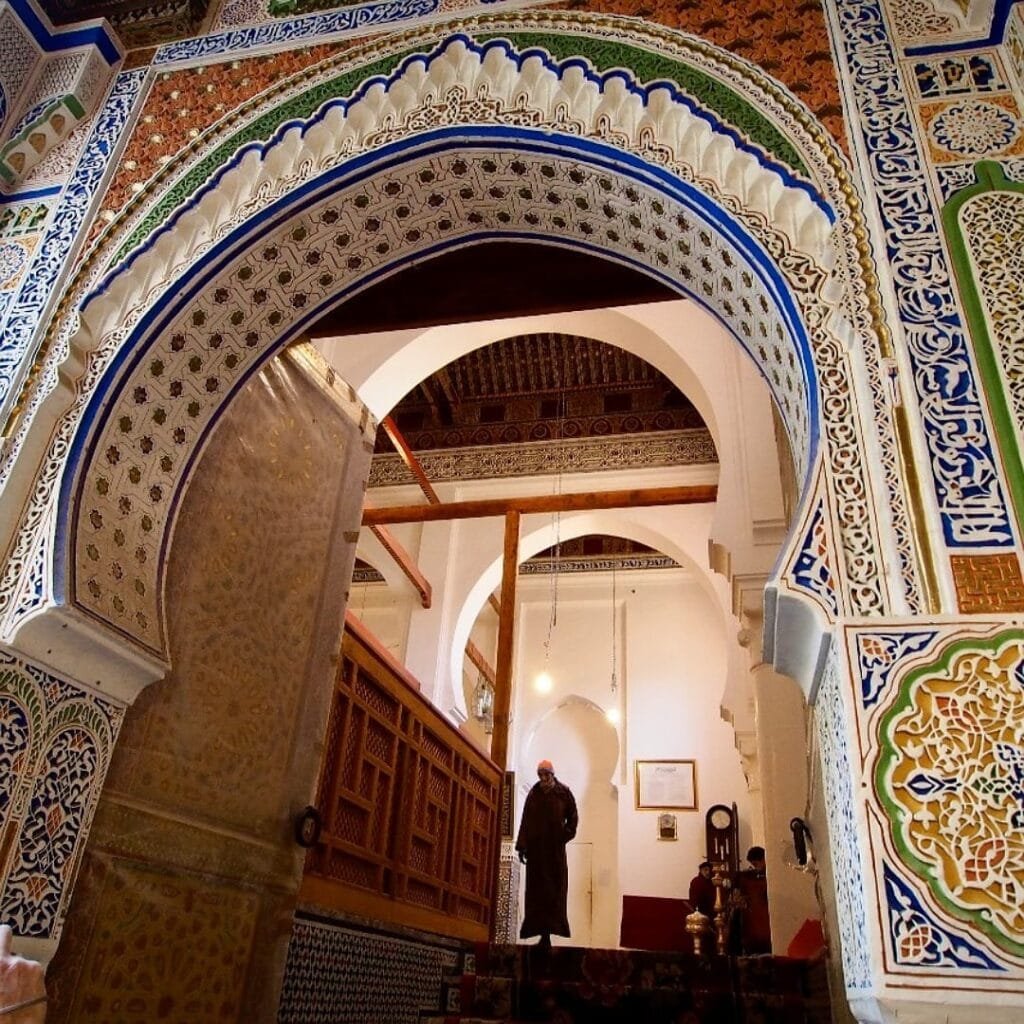


3. Zawiya of Sidi Ahmed Tijani
Hidden in the winding alleys of Fez’s medina, the Zawiya of Sidi Ahmed Tijani offers a calm escape. Here, peace flows between the ancient walls. Sidi Ahmed Tijani was a respected Sufi master. He founded the Tijaniyya order. This path is important in Sufism and has spread widely across Africa and beyond. It left a deep mark on Islamic spirituality.
This zawiya (spiritual lodge) is more than a religious site. It shows Morocco’s rich Sufi heritage. It reflects a long history of asceticism and mysticism. The zawiya is open only to Muslims, but all can enjoy its beautiful exterior. Its architecture shows true Islamic art.. Visitors can also feel the calm, sacred energy surrounding the place.
As you stand before the zawiya’s gates, you can feel the spiritual ambiance that draws devotees and visitors alike. Pause to admire the building’s details. Notice the elegant inscriptions and colors that spark reflection and reverence. Being near this holy place gives you a glimpse into the spiritual life of Fes. This city honors many saints and righteous figures.
Travelers who love culture and spirituality should visit the Zawiya of Sidi Ahmed Tijani. This site offers a chance to explore the deep spiritual layers that make Fes so unique. It’s a chance to explore a lesser-known but important part of the city’s history and its cultural and religious identity. Do not hesitate to add this distinctive site to your list of explorations in Fes.
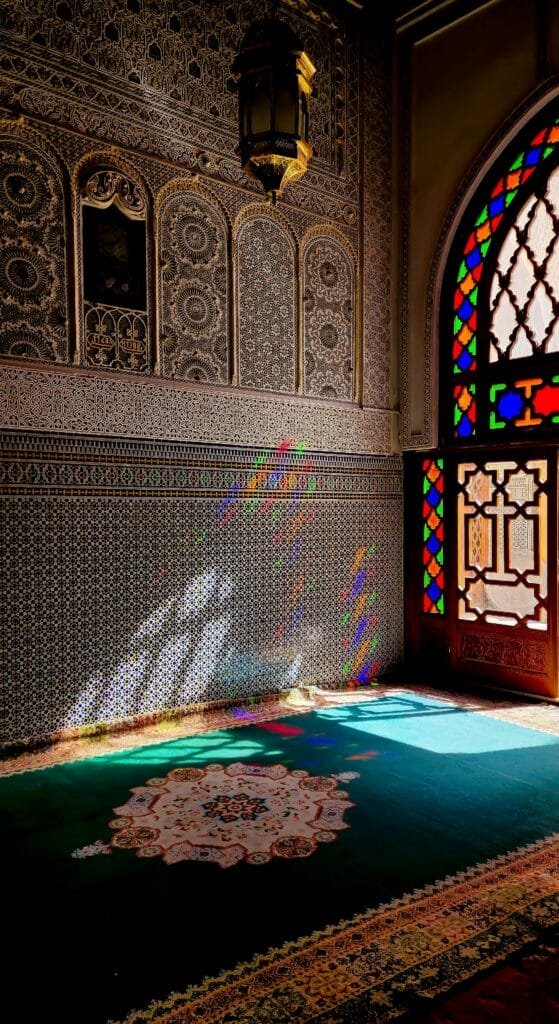
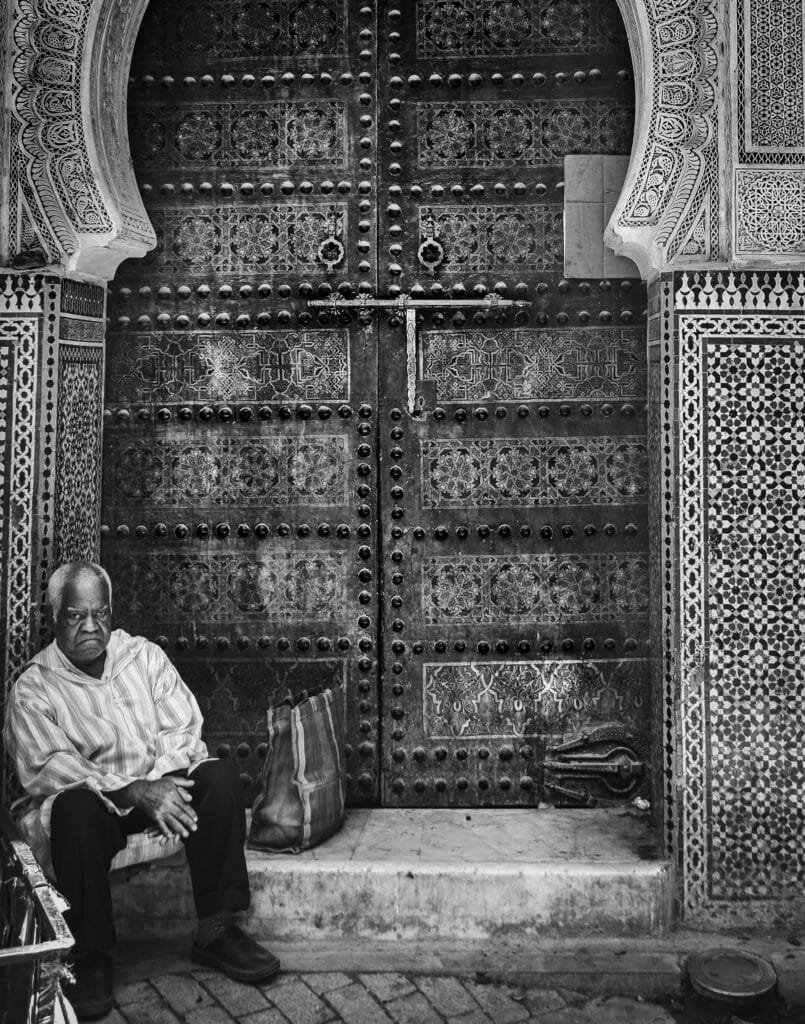
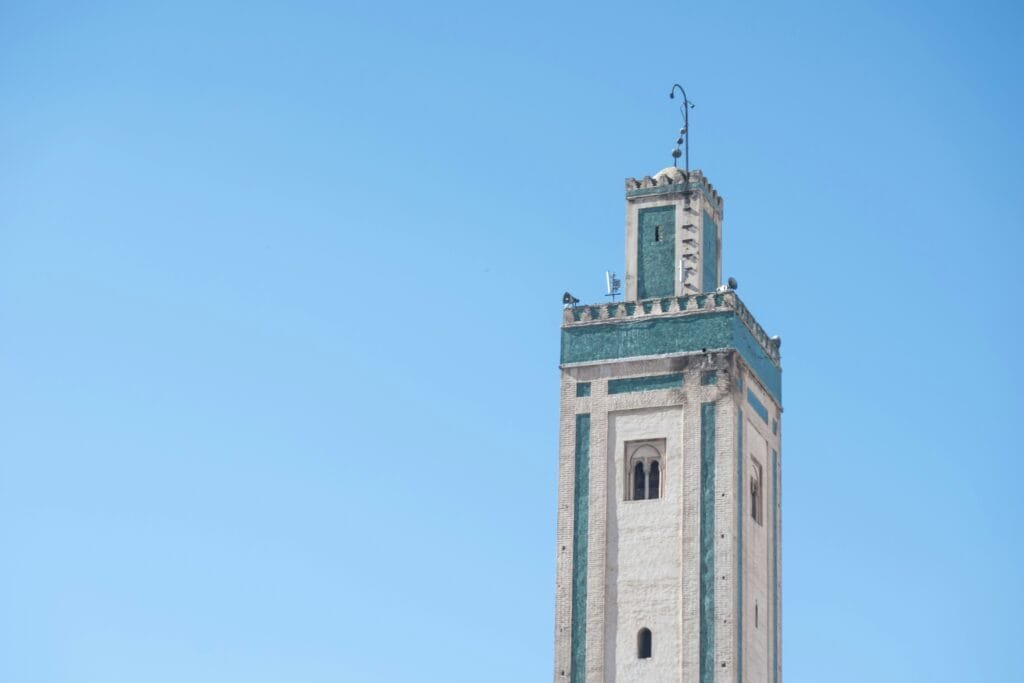


4. Chouara Tannery
A trip to Fes isn’t complete without visiting the famous Chouara Tannery. It’s the oldest and most well-known leatherwork in the city. For over a thousand years, leather has been made using traditional methods. This practice has stayed mostly the same despite the passing years.
From the terraces above, you’ll see a lively view of colorful dye pits. Skilled artisans work hard, turning raw hides into beautiful Moroccan leather goods. These items are famous for their quality and craftsmanship.
Visiting the Chouara Tannery is a full sensory experience. You see rich colors all around. You smell a unique aroma steeped in history. You can feel the authenticity from the craftsmen at work. Everything comes alive right before your eyes. You will see the stages of leather tanning. First, there’s cleaning and treatment. Then, watch the vibrant dyeing and drying processes. You will gain a deep appreciation for the skill and effort in this traditional craft.
This is a rare chance to explore one of Fes’s oldest traditions. You can also pick up a unique, handmade souvenir. It carries the scent of history and the true artistry of this ancient city. Be sure to allocate ample time to explore this living landmark that embodies the very spirit of Fes’s artisanal heritage.

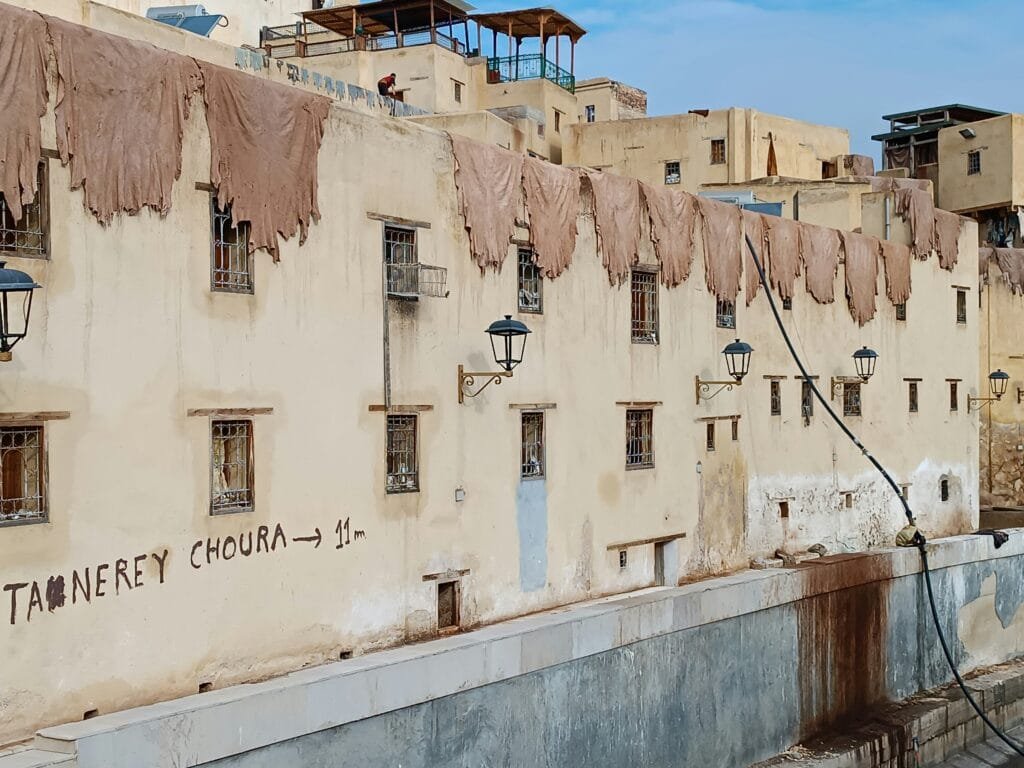
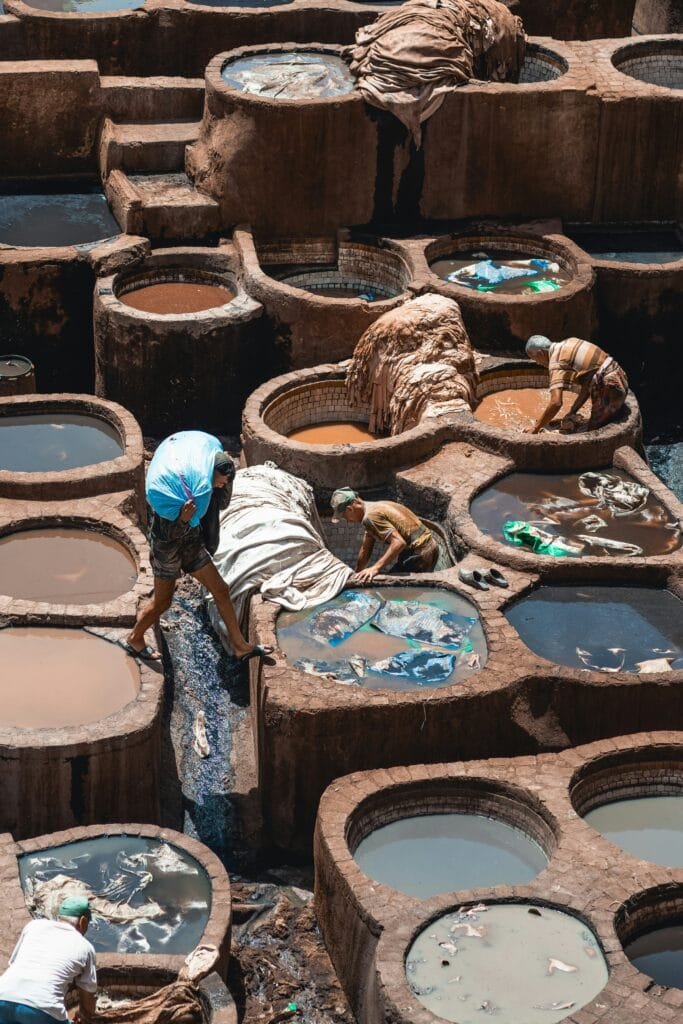
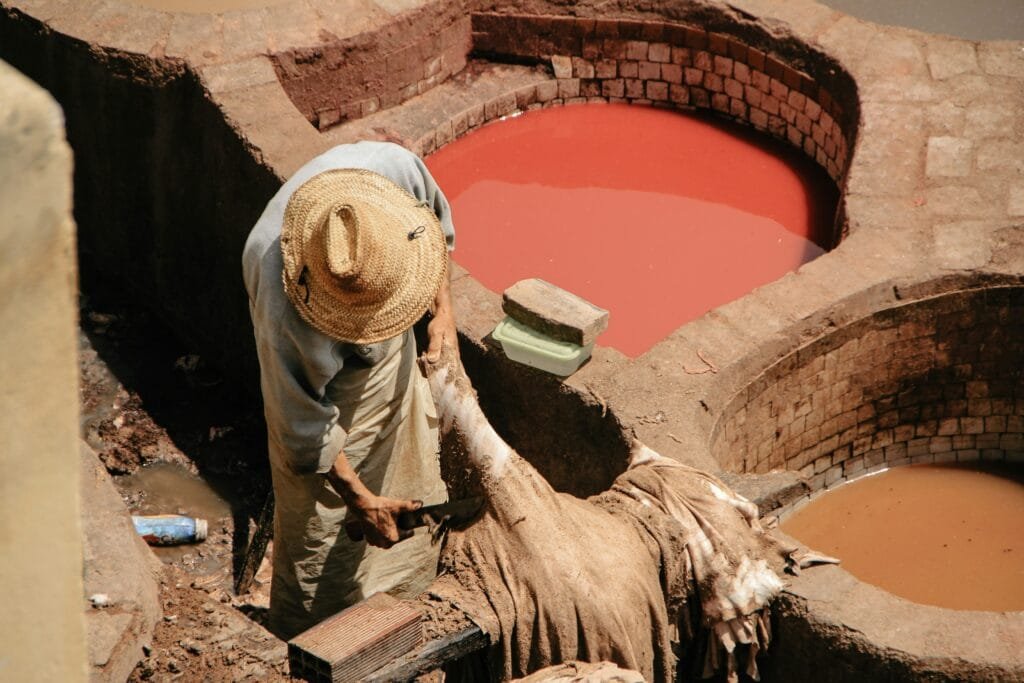
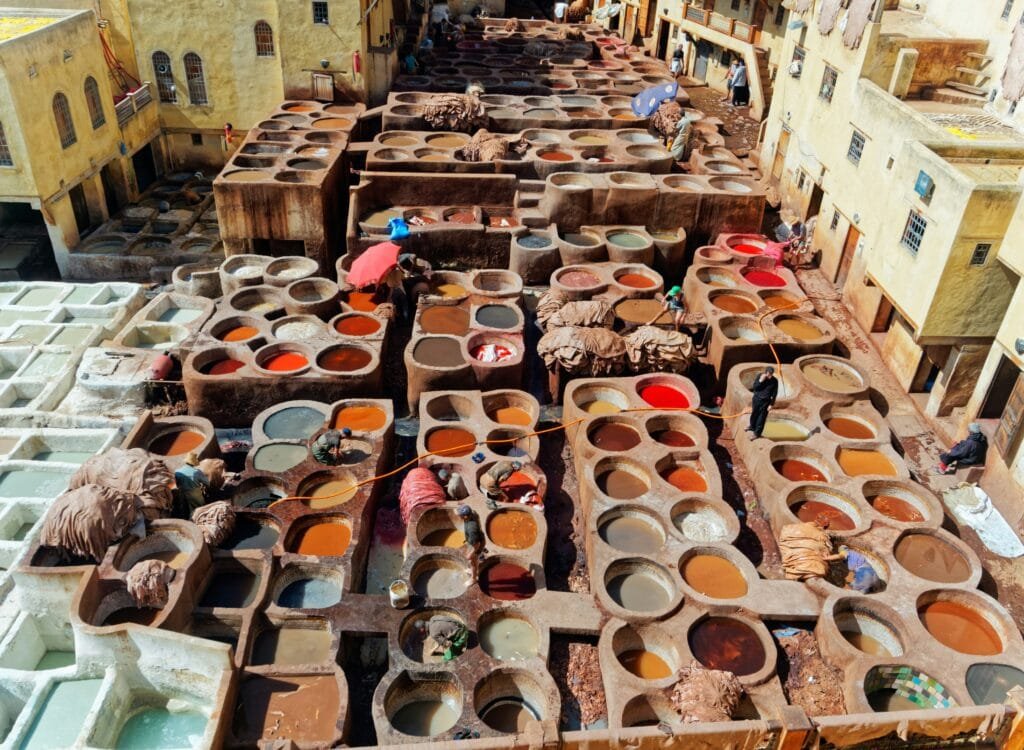
5. Bab Boujloud (The Blue Gate)
Bab Bou Jeloud, or the Blue Gate, is a stunning entrance. It brightly welcomes you to the ancient Medina of Fes. Built in 1913, this stunning structure is more than a landmark. It’s a symbol of the city, full of history and life.
The gate captivates with its unique architectural design and intricate mosaic decorations. The shimmering blue tiles on one side of the gate will catch your eye. They symbolize Fes and its rich history. The opposite side shines with emerald green tiles. These tiles represent Islam, the nation’s religion and culture. This mix of colors shows the strong connection between the city’s identity and its spiritual beliefs.
Starting your journey at Bab Bou Jeloud reveals the old city’s secrets. It leaves a magical first impression. As you walk through this grand gateway, you enter a maze of narrow streets. You’ll see busy souks and hidden treasures just waiting for you to find them. It serves as the perfect starting point to capture iconic souvenir photos that embody the beauty and authenticity of Fes.
Bab Bou Jeloud is more than just a beautiful structure. It serves as a key meeting point. It links the past with the present and connects the outside world to the lively heart of the old city. As you stand at this gate, you’ll sense you are entering another world. This place fiercely guards its traditions and customs. At the same time, it warmly welcomes visitors from around the globe. Start your journey in Fes at Bab Bou Jeloud. Get ready for an unforgettable experience filled with rich history and lively daily life.

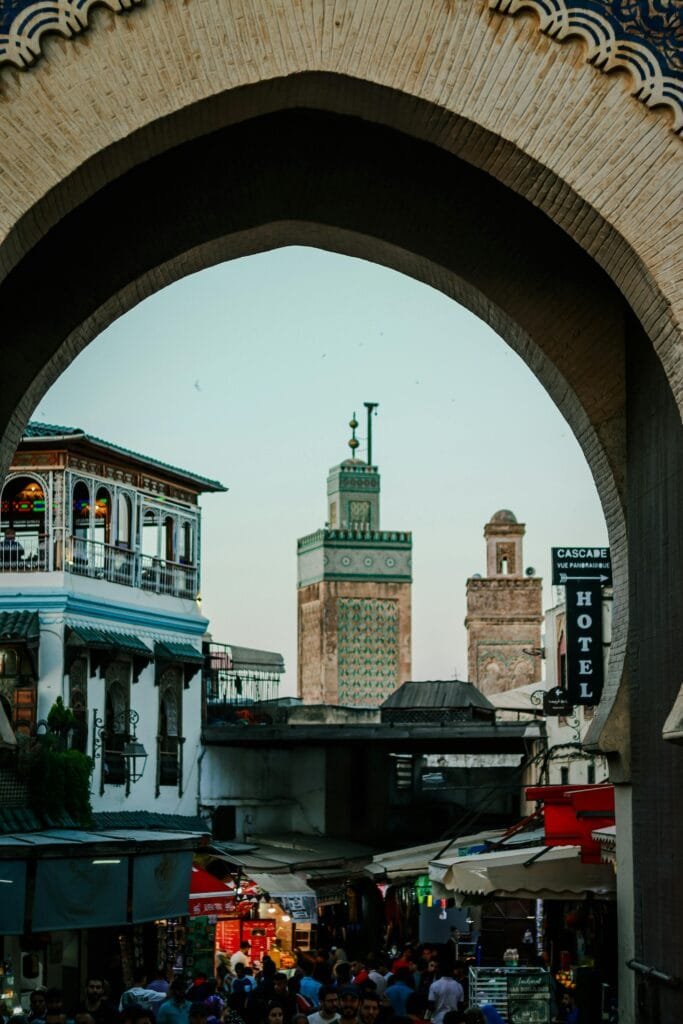

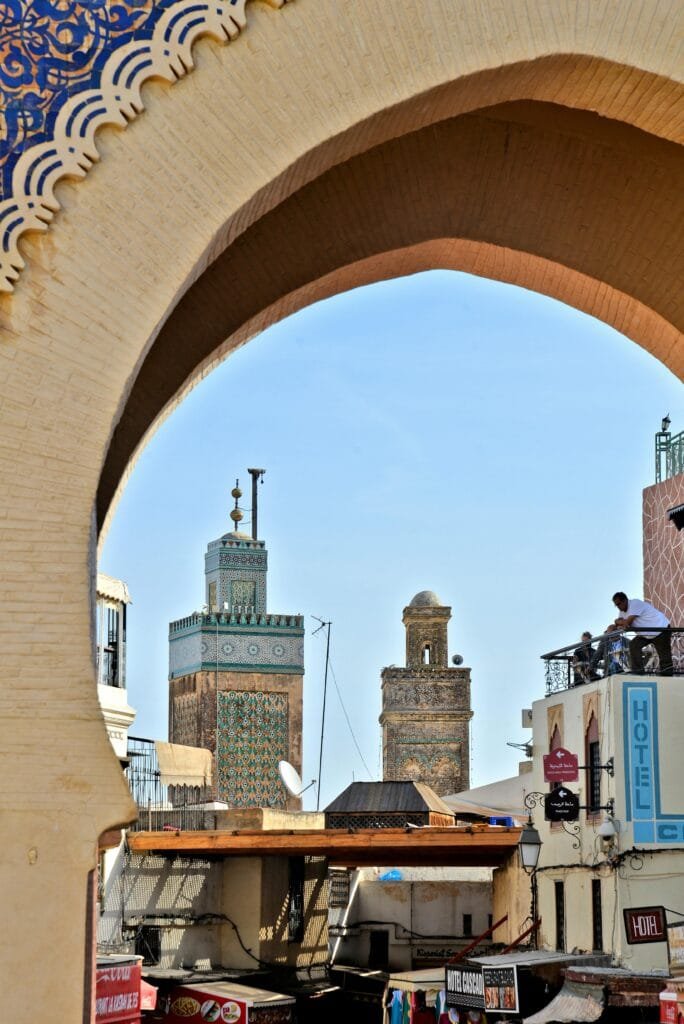

6. Place Seffarine
Tucked within the ancient medina of Fez lies Place Seffarine, one of the city’s oldest and most iconic squares. This historic plaza is not just a pretty spot. It’s a place where knowledge, tradition, and craftsmanship come together in harmony.
📚 Al-Qarawiyyin Library
One of the oldest libraries in the world, founded in the 9th century. It holds a priceless collection of ancient manuscripts and has been a beacon of learning and culture for over a millennium.
🏫 Seffarine Madrasa
Built in 1271, this was the first educational institution of the Marinid dynasty in Fez. The madrasa welcomed students from all over Morocco. It has stunning Moroccan architecture. You’ll see colorful zellige tiles, intricate woodwork, and a tranquil courtyard.
🔨 The Copper Market
Place Seffarine is home to the coppersmiths’ quarter. Here, artisans craft copperware by hand. The square fills with the rhythmic sound of hammering. This is a living echo of Fez’s rich artisanal heritage.
Visiting Place Seffarine takes you into the heart of Fez’s art and intellect. It’s a must for anyone who loves history, culture, and traditional crafts.

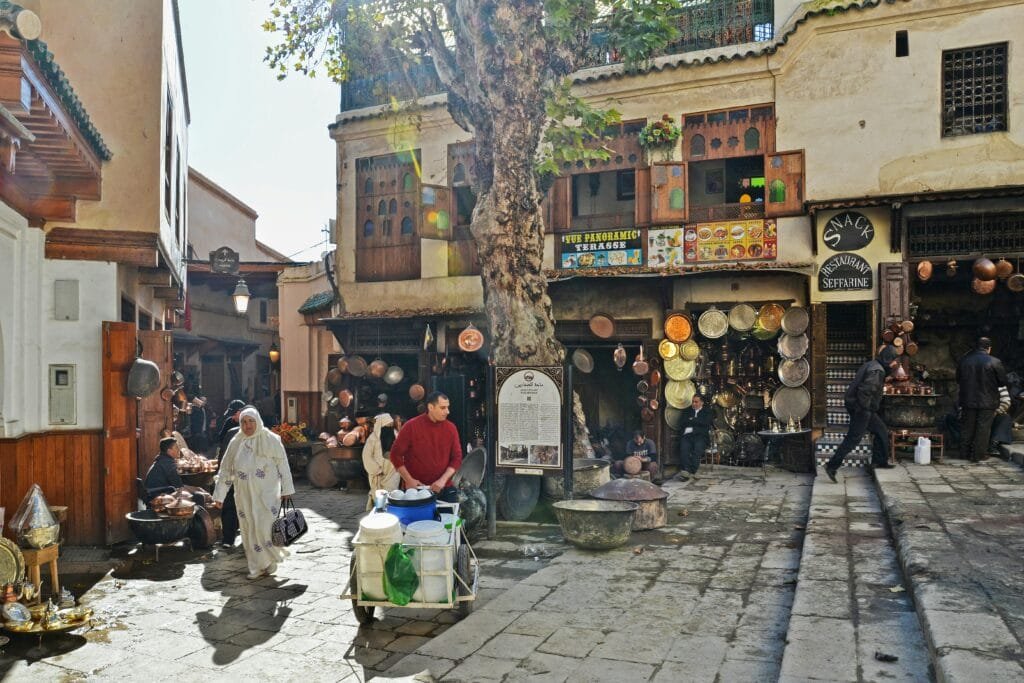
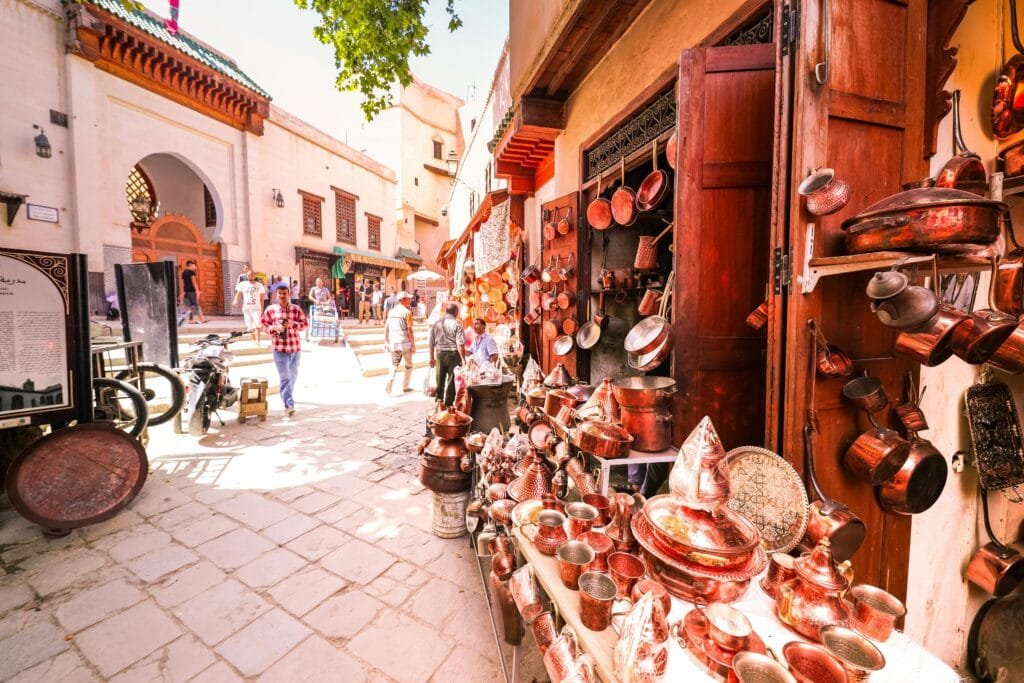

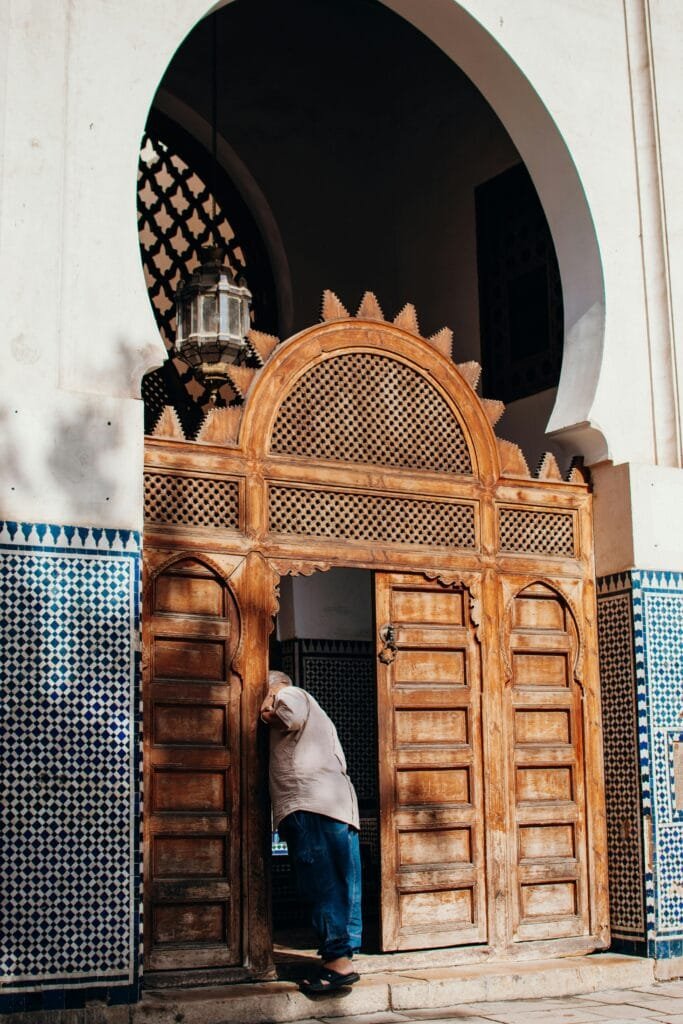
7. Al-Andalus Mosque
Located in the heart of Fes el-Bali, along the banks of the Fez River, the Al-Andalus Mosque is one of the oldest and most beautiful mosques in Morocco. It was founded around 859 AD by Mariam al-Fihri, the sister of Fatima al-Fihri, who founded the famous Al-Qarawiyyin Mosque. Together, these two sites form a spiritual and historical pair that shaped the identity of the city.
🌍 Why Visit?
- It shows the Andalusian-Moroccan heritage. It tells how Muslim refugees from Andalusia brought their knowledge, culture, and skills to Fez.
- The mosque showcases beautiful Islamic design. It has elegant arches, detailed stucco work, and a finely carved wooden minbar.
- Non-Muslims can’t go inside, but the outer façade, courtyard views, and peaceful surroundings are worth seeing.
📍 Location:
Located in the Andalusian Quarter, just across the river from Al-Qarawiyyin Mosque, it’s a great stop on any walking tour of the old medina.
Visiting the Al-Andalus Mosque lets you reflect and see the rich art and spirit of Islamic culture in Fez.
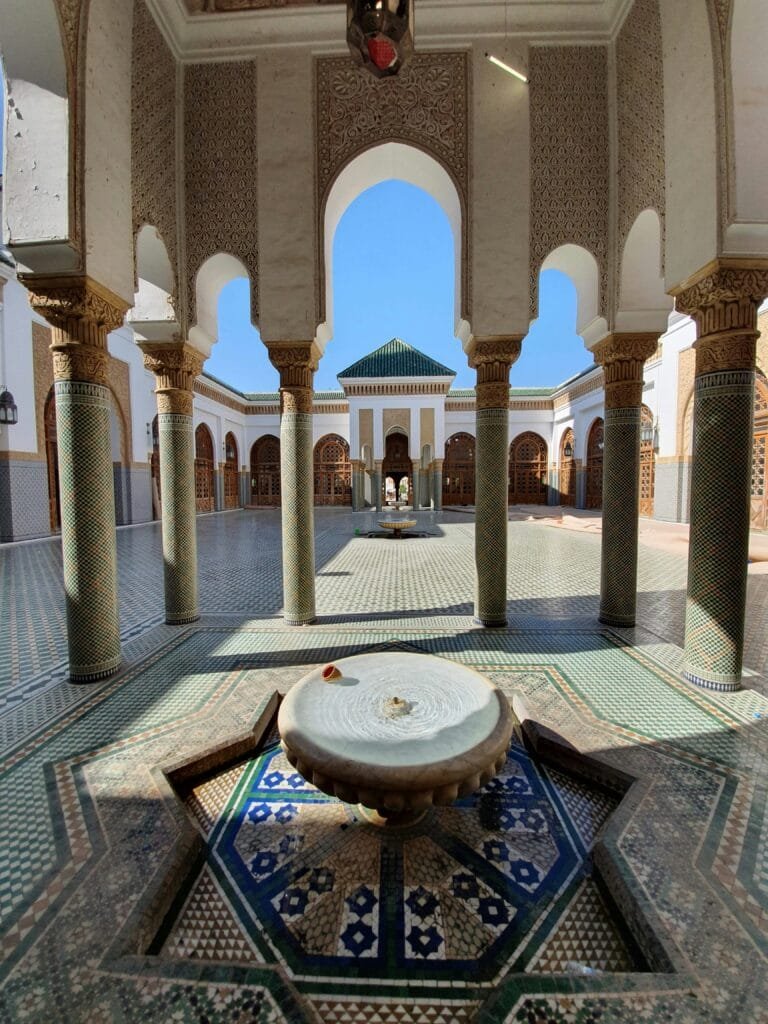
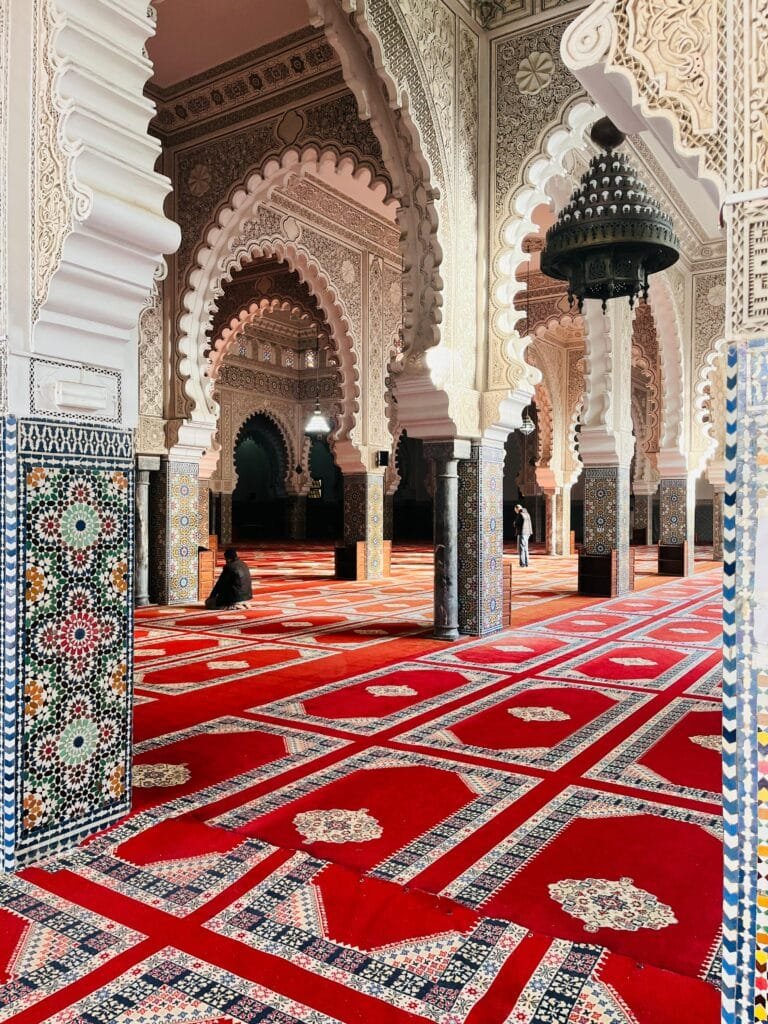
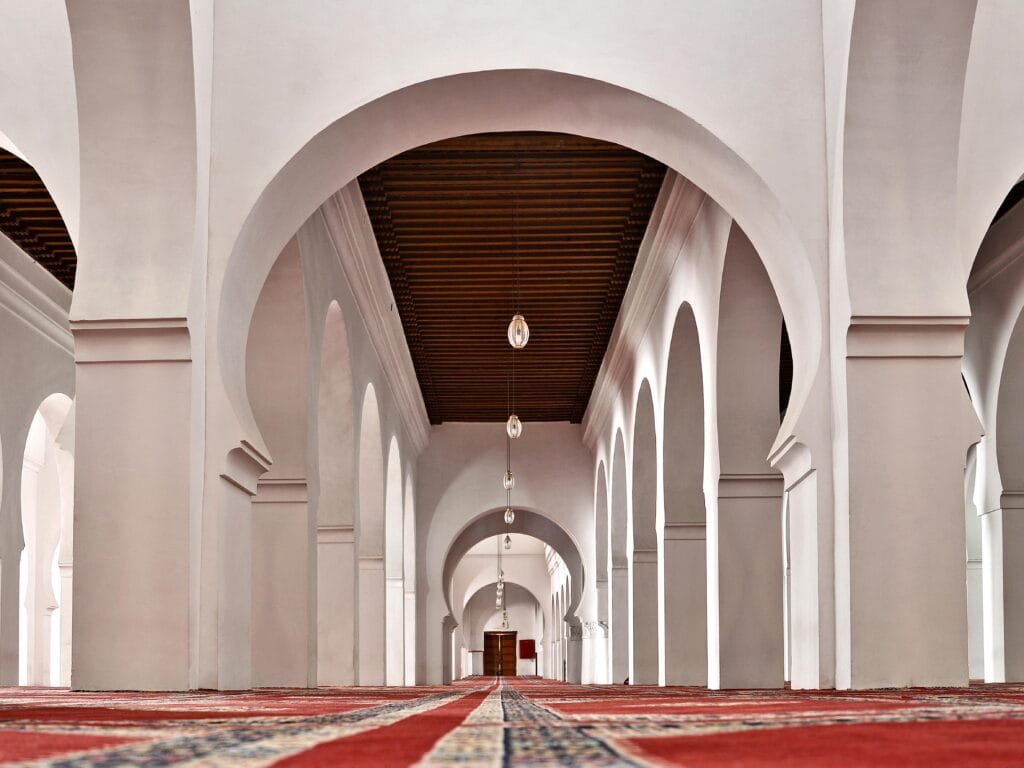
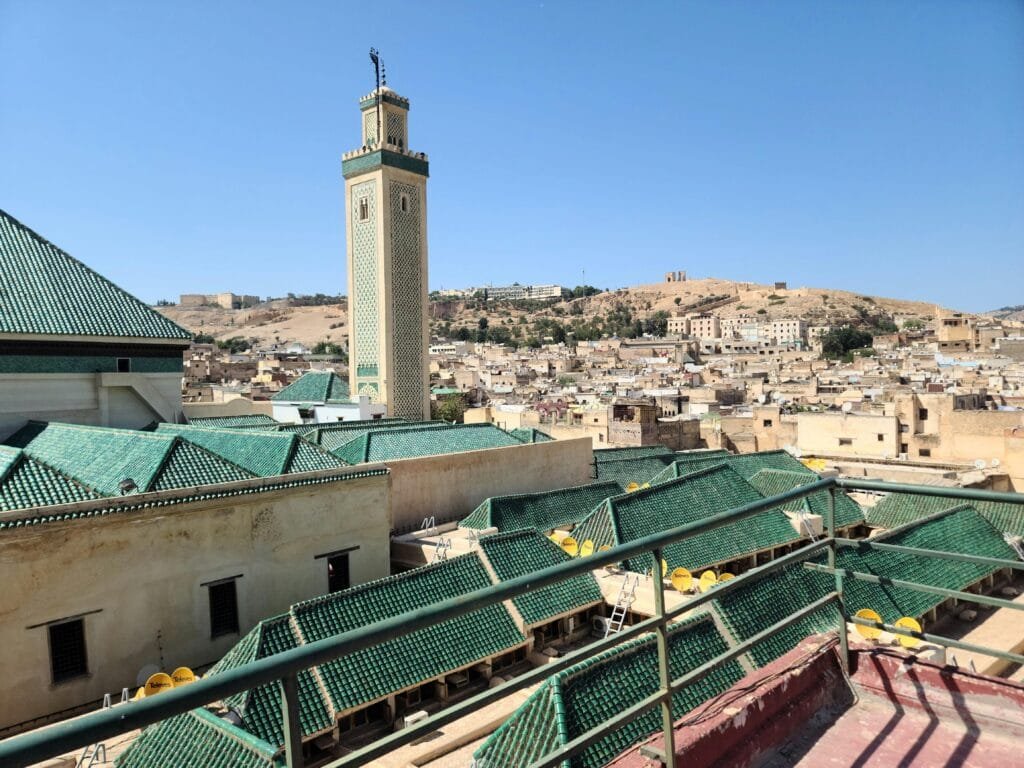
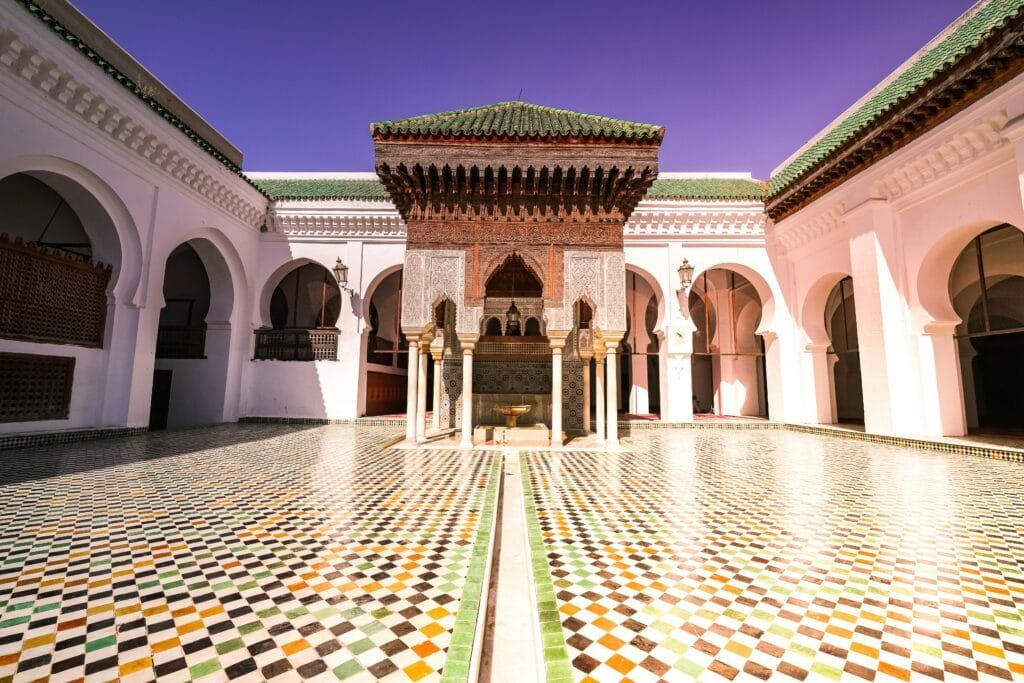
8. Nejjarine Square
Located in the heart of Fez’s ancient medina, Nejjarine Square is one of the city’s most charming and historic plazas. The square is named after the “Nejjarine” (woodworkers) who have worked here for centuries. It buzzes with traditional Moroccan craftsmanship.
🏛️ Highlights of the Square:
- Nejjarine Museum of Wooden Arts & Crafts is in a restored 18th-century caravanserai (funduq). The museum features a stunning collection of wooden tools, carved doors, furniture, and art. It celebrates Morocco’s rich woodworking heritage.
- Nejjarine Fountain: This lovely public fountain in Fez has bright zellige tiles and carved wood. It was a key place for travelers and traders to refresh.
🌍 Why Visit?
- Surrounded by traditional shops selling handcrafted furniture, wooden decor, and artisanal treasures.
- A perfect blend of living craftsmanship and historic beauty.
- Centrally located, it’s a must-see stop on any medina tour, close to major landmarks like the Al-Qarawiyyin Mosque and Attarine Souk.
Nejjarine Square takes you into the rich art and culture of Fez. Here, history and handmade beauty shine bright.
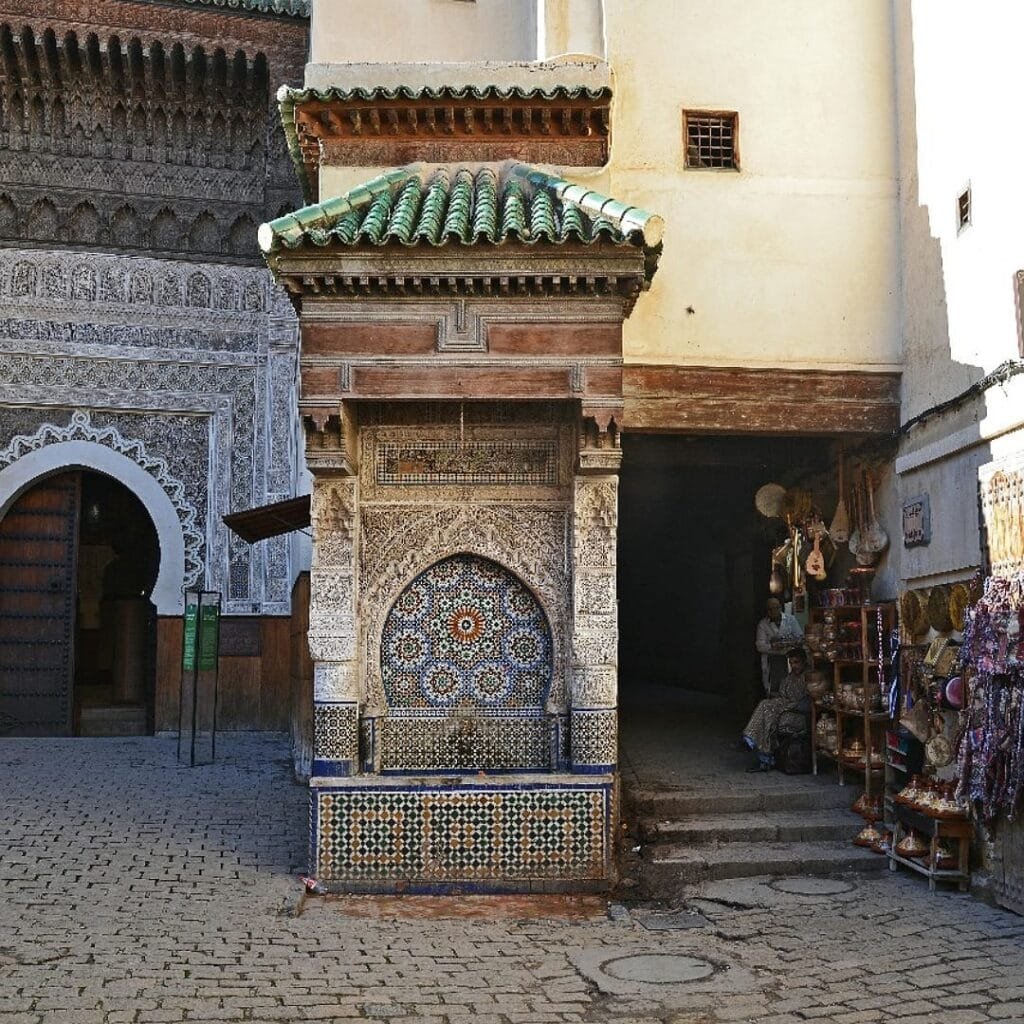

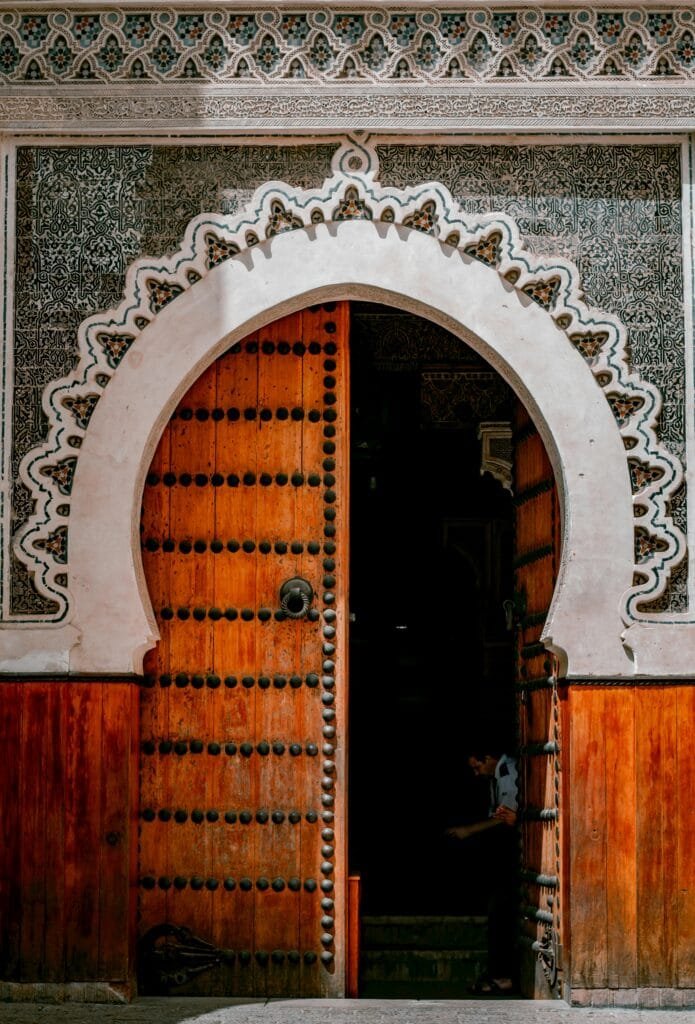

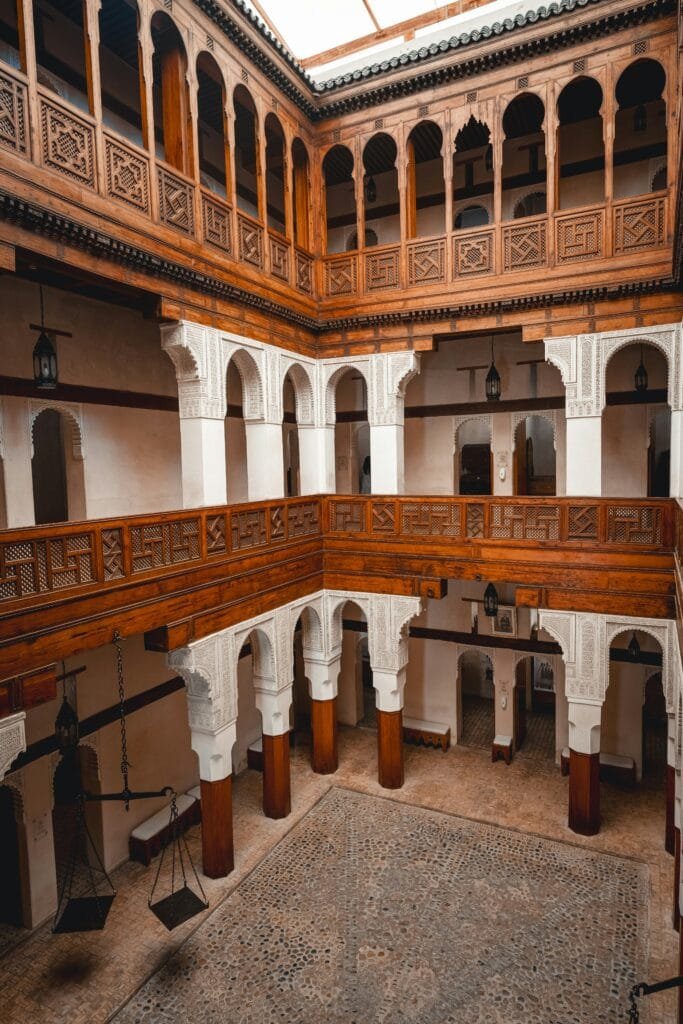
9. Souk as-Sabbaghine
The Dyers’ Quarter – Living Colors of Moroccan Tradition:
In the heart of Fez’s old medina is the Dyers’ Quarter (Souk as-Sabbaghine). It’s one of Morocco’s oldest and liveliest spots for fabric and leather dyeing. This market is a living display of centuries-old artisanal skills, still practiced entirely by hand.
🌈 What to Expect:
Rows of colorful dyeing vats, where fabrics are hand-dipped into natural dyes made from plants, spices, and minerals.
Skilled artisans moving cloth between vats in a colorful and captivating scene full of life and tradition.
Shops offer hand-dyed Moroccan fabrics like silk, wool, and cotton. These materials are used for traditional clothing, including djellabas and kaftans.
📸 A Unique Cultural Experience:
Ideal for photography, especially from the terraces overlooking the dyeing area.
See how dyeing was done before machines and synthetic chemicals. Experience the art of ancestral craftsmanship.
🧭 Location:
Located near The Place Seffarine and Seffarine Madrasa, this site is easily included in any guided tour of Fez el-Bali.
Visiting the Dyers’ Quarter is a visual and cultural journey, offering a rare glimpse into the colors and soul of Moroccan heritage.
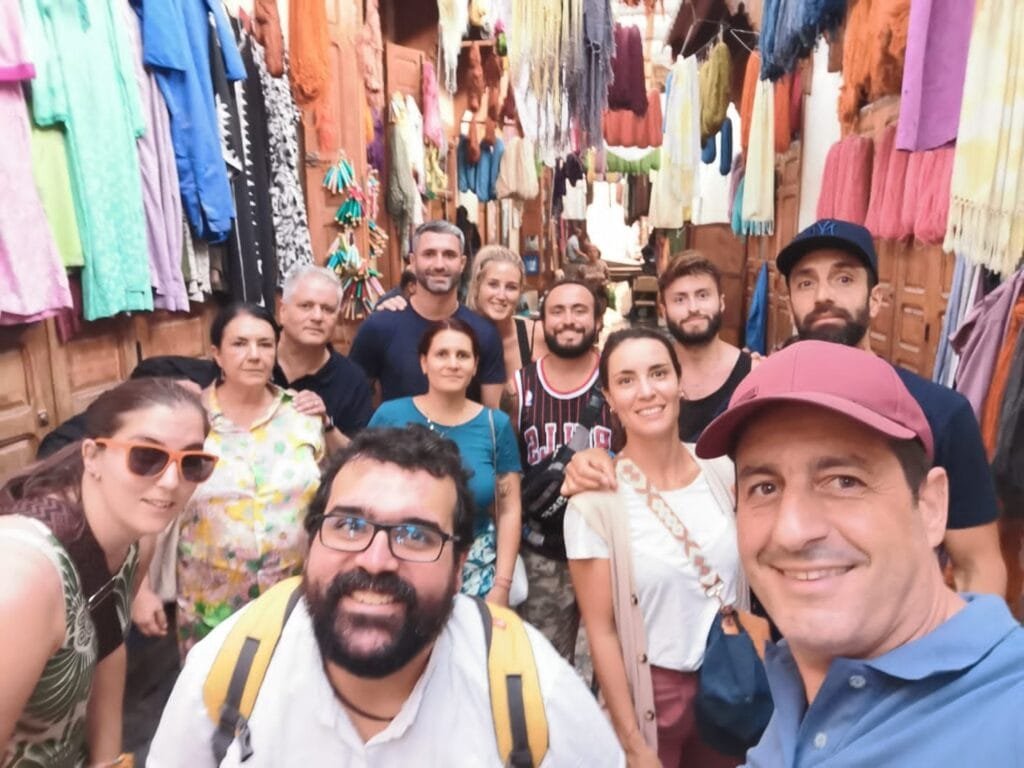
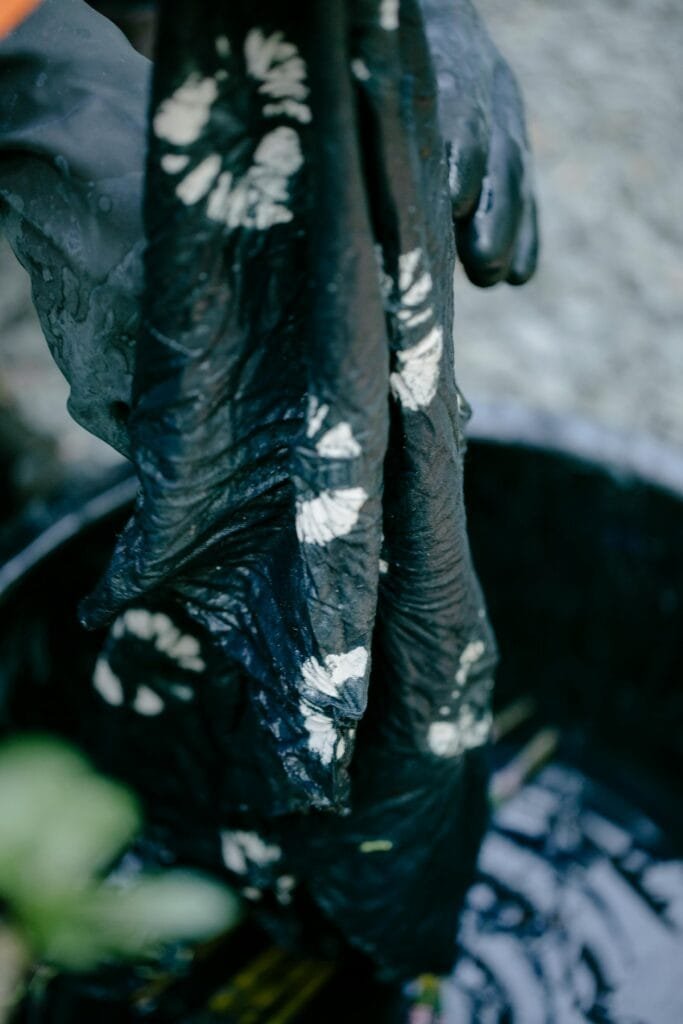
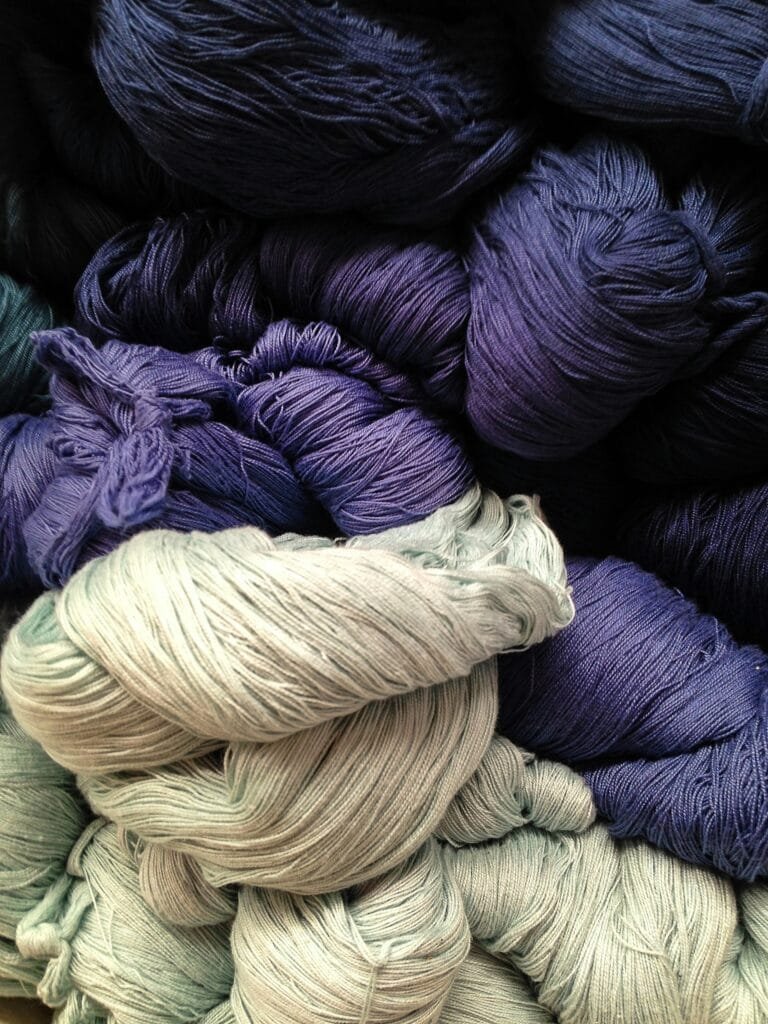

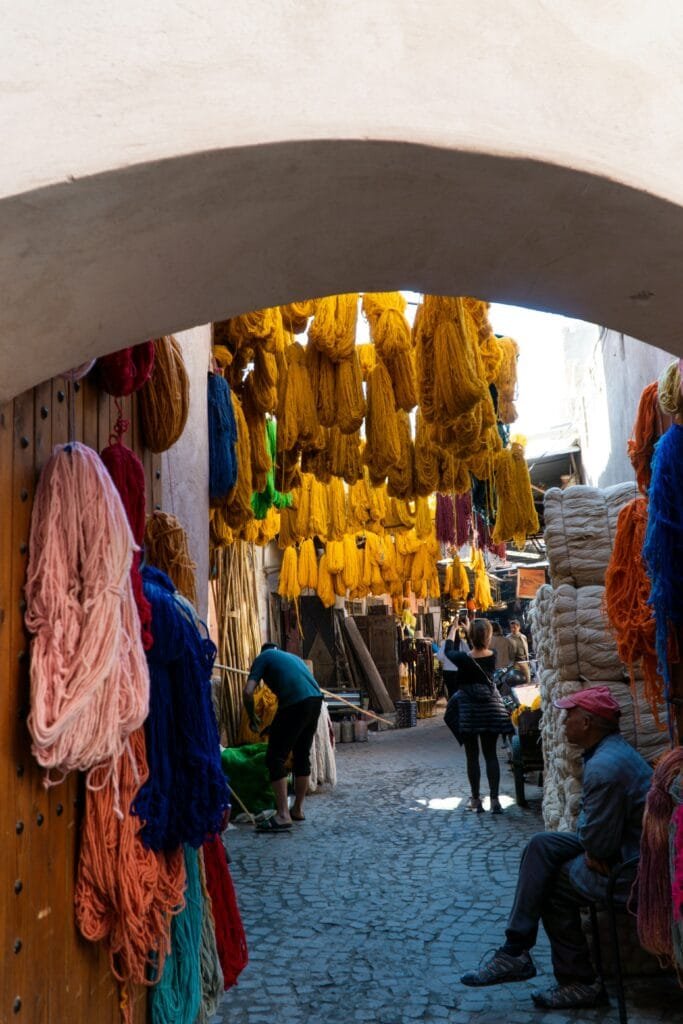
10. Bou Inania Madrasa
The Bou Inania Madrasa sits in the center of Fez’s old medina. It is one of Morocco’s most impressive religious and architectural sites. Built in the 14th century by Sultan Abu Inan Faris of the Marinid dynasty, it was both a school (madrasa) and a mosque. This mix is rare in Islamic architecture.
🌟 Highlights:
- Lovely Moroccan art: The madrasa displays carved cedar wood, detailed stucco, and eye-catching zellige tiles. It’s a true masterpiece.
- Spiritual and educational center: It once hosted some of the best scholars and students of Islamic sciences in North Africa.
- Tranquil courtyard: This peaceful space features a central fountain. It’s perfect for reflection and enjoying the beauty of traditional design.
💳 Entry Fee:
To visit the Bou Inania Madrasa, you need to pay a small fee of 2 Euros. This is a small price for a look at centuries of Moroccan history and art.
📍 Location:
Just steps away from the bustling Talaa Kebira street, the madrasa is easily accessible and an essential stop on any Fez walking tour.
Visiting Bou Inania offers a deep dive into the spiritual, artistic, and intellectual heart of historic Fez — don’t miss it!
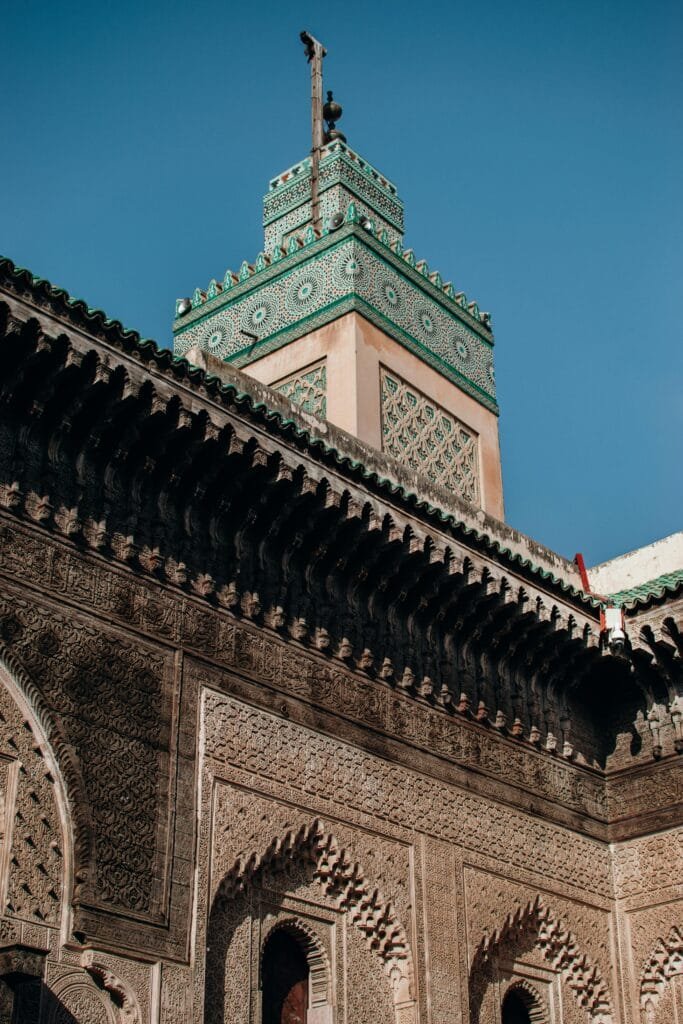


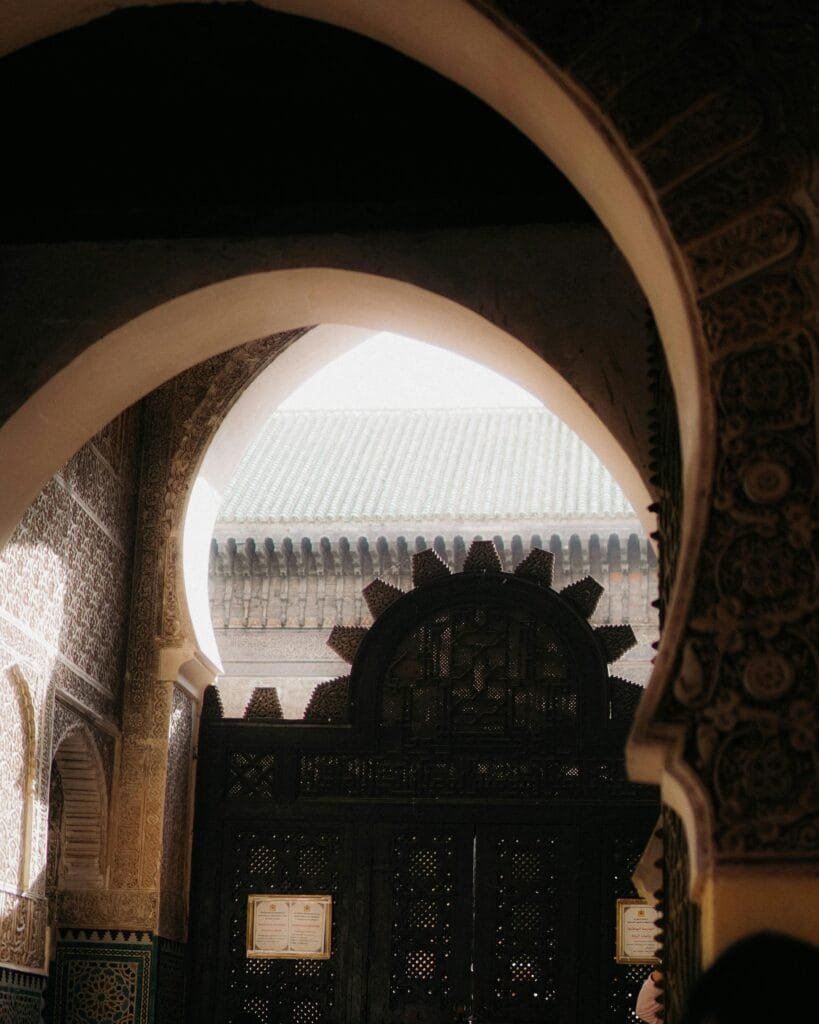
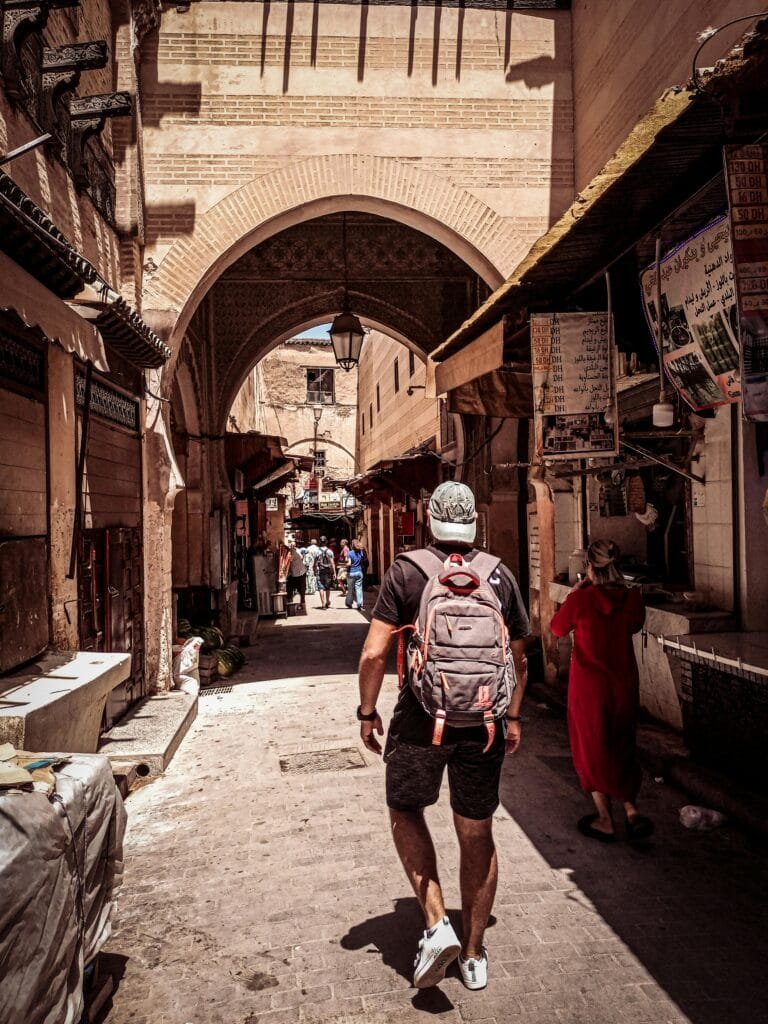
11. Al-Attarine Madrasa
The Al-Attarine Madrasa was built from 1323 to 1325 by Sultan Abu Sa’id Uthman II of the Marinid dynasty. It is known as one of the most beautiful theological schools in Morocco. Located near the famous Al-Qarawiyyin Mosque, it served as a residence and study center for students of religious sciences.
🌟 Highlights:
The madrasa showcases amazing craftsmanship. It has beautiful carved cedar wood, detailed stucco work, and stunning zellige tile mosaics. This mix highlights the best of Islamic artistry.
Harmonious architecture: The layout includes a peaceful courtyard, a prayer hall, student rooms, and a central marble fountain. Each element shows refined symmetry and sacred geometry.
Historic location: Its name comes from the nearby Souk al-Attarine (Spice Market), adding a sensory cultural touch to your visit.
💳 Entry Info:
Visitors can enter the madrasa for a small fee (typically around 20 MAD or 2 Euros).
It’s a popular stop for architecture enthusiasts, history lovers, and photographers.
🧭 Easy to Visit:
Located in the medina, it’s a short walk to the Bou Inania Madrasa, Nejjarine Square, and Al-Qarawiyyin Library. This makes it a great spot for a historical walking tour.
Al-Attarine Madrasa takes you on a stunning journey through the spiritual and artistic heart of medieval Fez. It’s a must-see for every traveler.
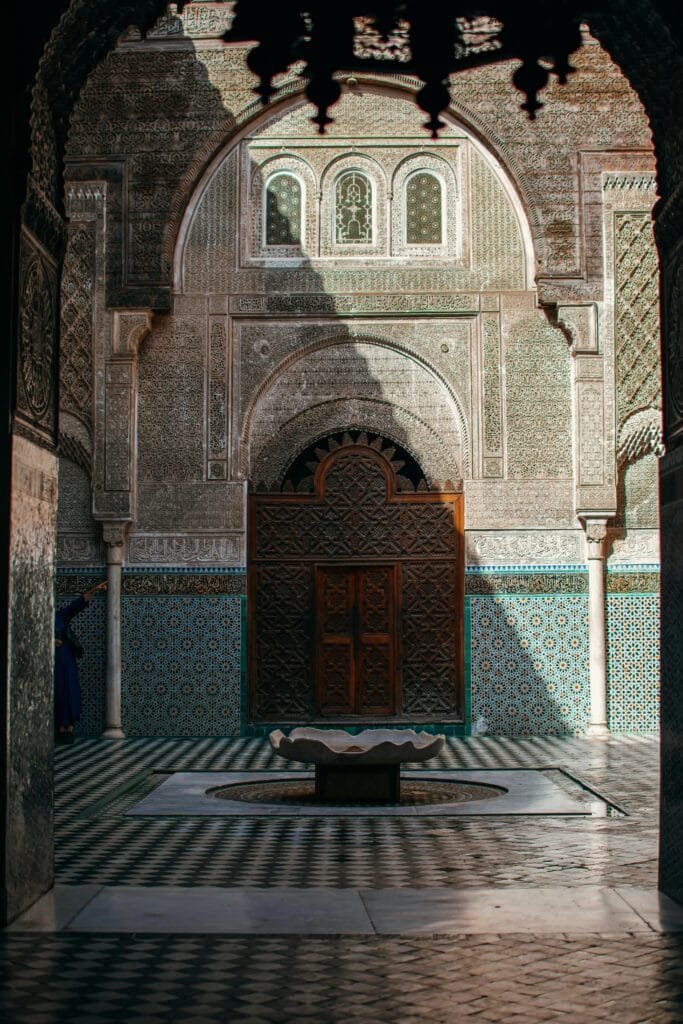
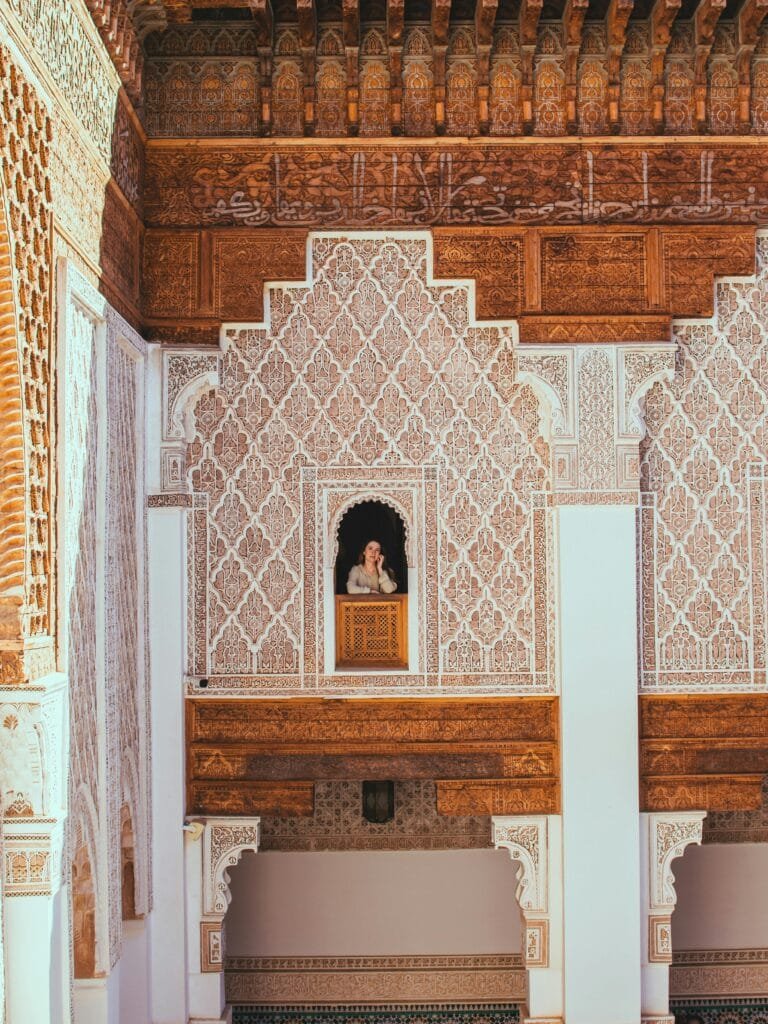

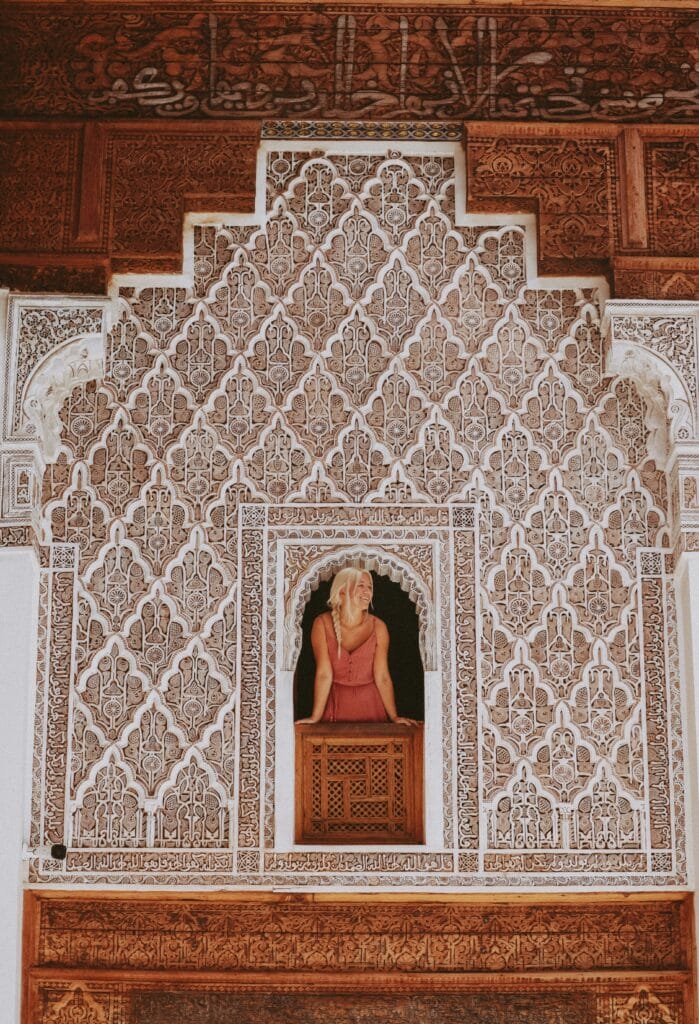
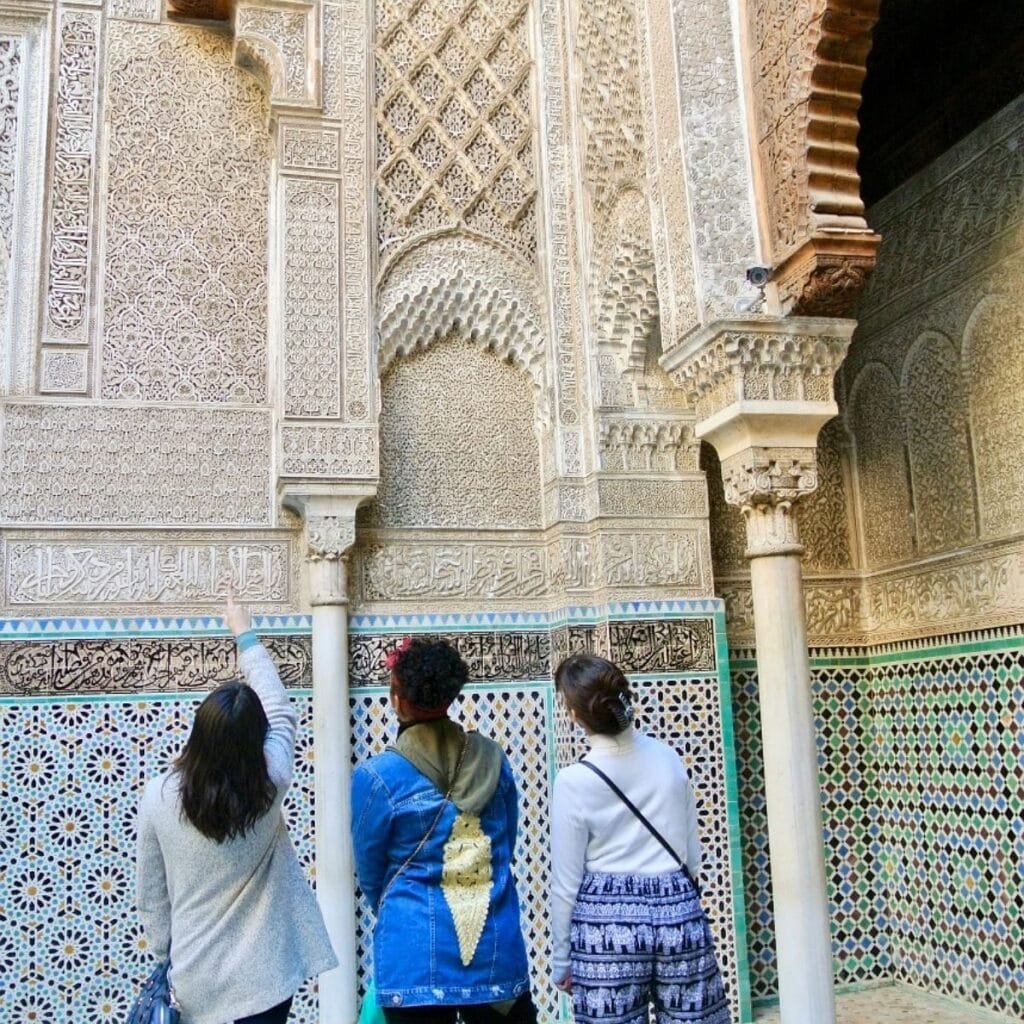
12. Royal Palace of Fez
The Royal Palace of Fez (Dar al-Makhzen) is a key landmark in Morocco. It sits just outside the old medina, in the Fes el-Jdid district. Its beauty and history make it a must-see site. While the palace itself is not open to the public, its grand main gates are a popular attraction for tourists from around the world.
🌟 What Makes It Special:
- Magnificent Brass Doors: The palace boasts huge, golden bronze doors. They are framed with detailed zellige tiles and elegant cedar carvings. This showcases the beauty of traditional Moroccan craftsmanship.
- Royal Heritage: The palace is one of the King of Morocco’s official homes. It shows the city’s historical role as a key spiritual and political center.
- Photographer’s Favorite: The grand entrance is a top spot for photos in Fez. When sunlight hits the golden doors, they shine beautifully.
🧭 Location:
Situated in Fes el-Jdid, the palace is just a short walk from the Jewish Quarter (Mellah) and close to several gardens and monuments.
While you can’t go inside, the Royal Palace of Fez remains a must-see stop—an architectural treasure and a symbol of Morocco’s royal grandeur.
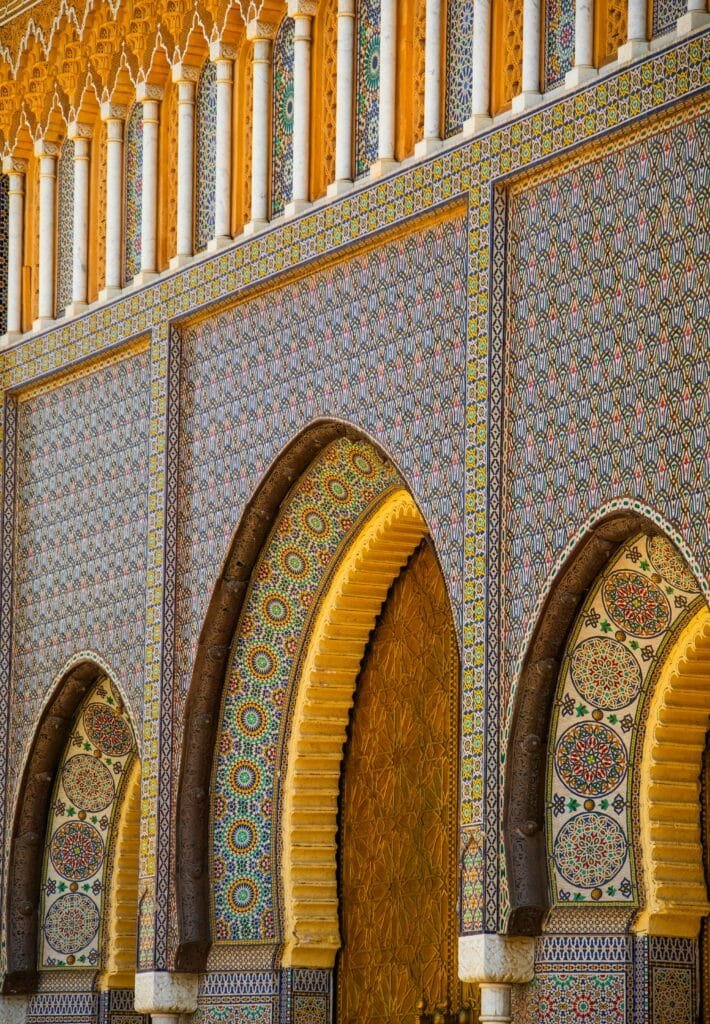
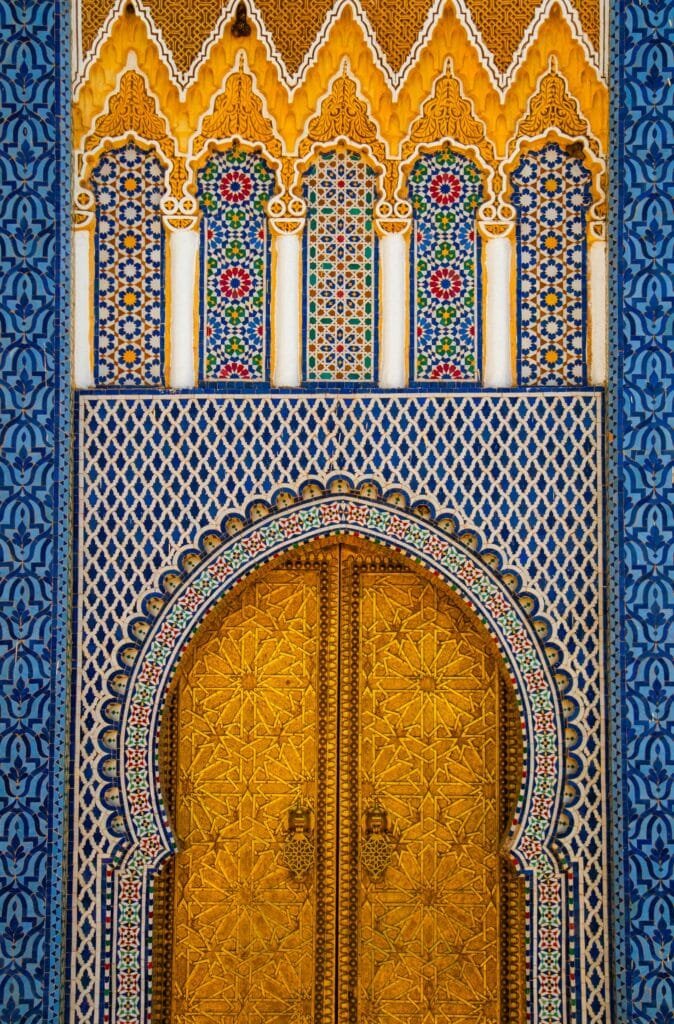
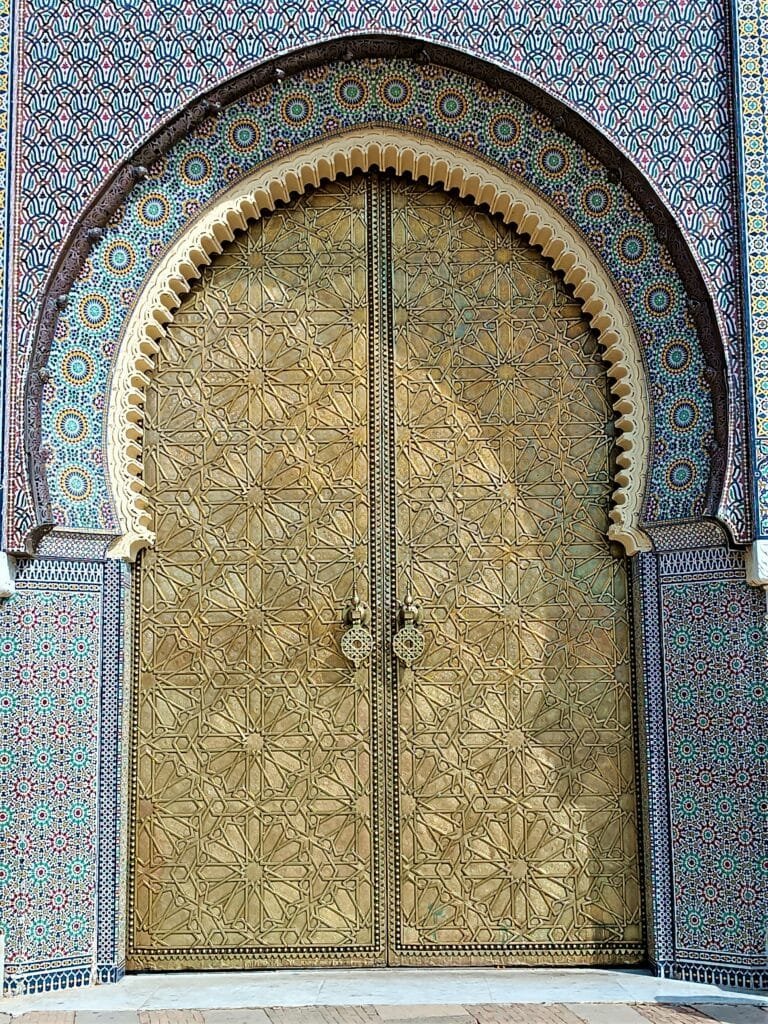
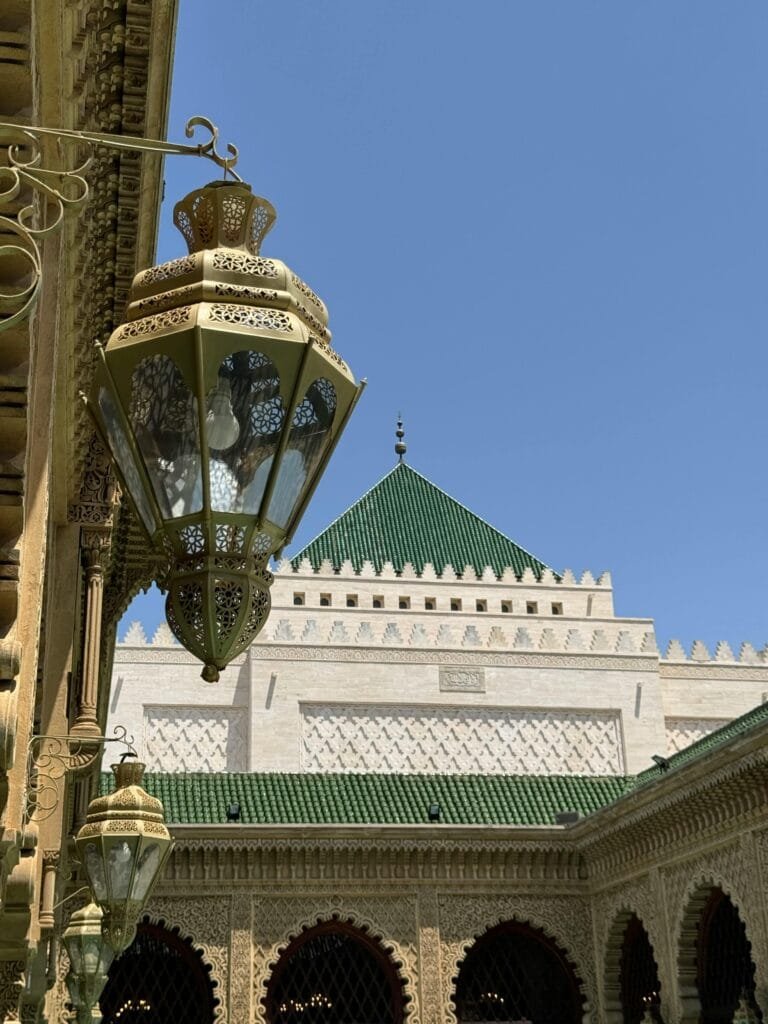
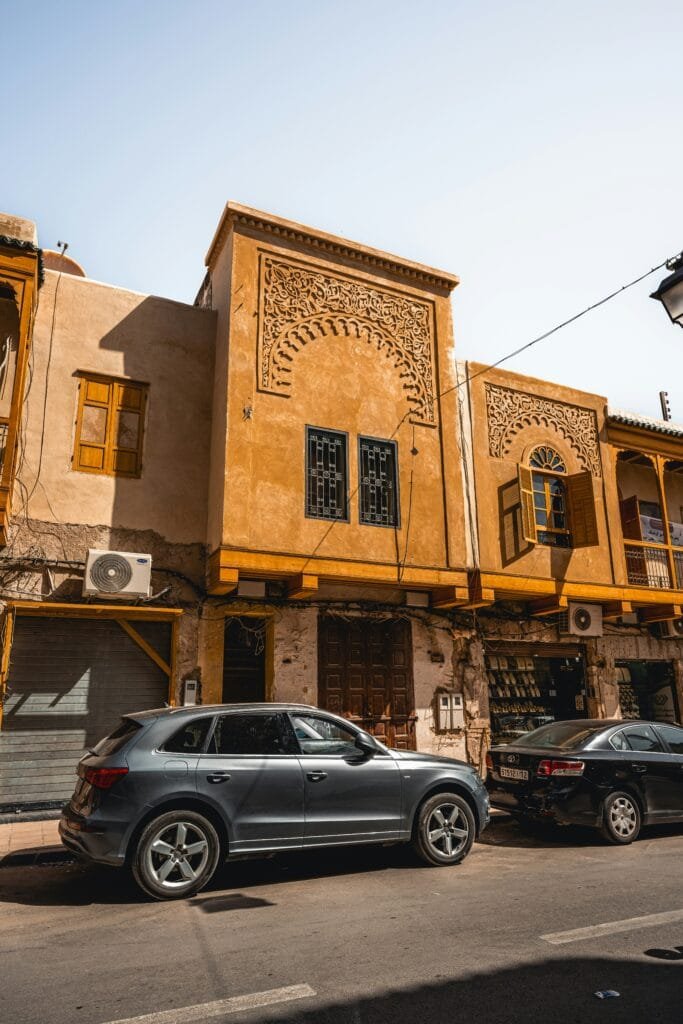
Top Traditional Crafts of Fez: Handmade Art That Captivates Visitors and Preserves Heritage
🧵 Discover the Timeless Crafts of Fez
Welcome to the captivating city of Fez! Prepare to step back in time and immerse yourselves in a world where ancient crafts flourish, whispering tales of a glorious past. For centuries, Fez has been the heart of Moroccan art. It is a lively center of trade and industry known throughout the Islamic world. The souks were full of treasures made by skilled artisans. Their talents were passed down through generations.
As you walk through the winding alleys of the medina, you’ll find a vibrant mix of traditional crafts. These crafts are key to the spirit of this amazing city. Take in the deep, earthy smell of the tanneries. Here, leather changes through old methods. It’s a vibrant display of color and tradition. Watch as hammers strike copper. Skilled engravers create stunning patterns on everyday items and art pieces.
You’ll be captivated by the stunning art of zellige tile-making. Each hand-cut piece fits perfectly, like a jewel in a beautiful mosaic. Appreciate the skill in embroidery, where colorful threads tell stories on fabric. Also, watch as woodcarvers turn simple wood into beautiful art with their careful hands.
Every corner you turn, every square you encounter, echoes with the legacy of Moroccan masters. These are not just crafts; they are living traditions. Families pass them down, keeping the soul and identity of Fez alive today. Come, witness the magic, meet the artisans, and take home not just a souvenir, but a piece of Fez’s timeless heritage. Your journey into the heart of Moroccan craftsmanship begins now!
- Leather Tanning in Fez
Picture the worn hands of a Fezzi tanner. They know their craft well. Years of hard work, maybe generations, shaped their skill.
Watch them work with amazing skill. They soak and clean the hides, using their deep knowledge of the materials. Watch how they endure. They work hard, often in tough conditions. Their commitment never wavers.
These artisans stand out because they stick to traditional methods. This practice has been handed down for centuries. They carefully prepare natural dyeing agents. They use lime, pigeon droppings, and vibrant colors from poppies or saffron threads. Their understanding of these natural ingredients shows a strong link to the land and its resources.
Their daily routine is a manual endeavor, a labor of love that demands both physical strength and meticulous attention to detail. It is a demanding job, often carried out amidst strong aromas and intense physical effort. It is a profession filled with pride in craftsmanship and the legacy they carry.
The significance of their work extends far beyond the beautiful leather they produce:
- Guardians of History: These tanners are the living custodians of a craft that stretches back over a millennium. They are the vital link to Fez’s glorious past, ensuring that these ancient techniques are not lost to the passage of time.
- Champions of Quality and Authenticity: In today’s world of mass production, their leather goods offer real quality and long-lasting durability. They reflect true craftsmanship. Each piece carries the mark of human skill and dedication.
- The Beating Heart of Fez’s Artistic Soul: These artisans are more than just workers; they are the embodiment of Fez’s artisanal spirit.
- A Living Tapestry of Human Endeavor: Witnessing these tanners at work is like stepping into a living history book. It’s a profound experience that speaks to the resilience of the human spirit, the beauty of patience, and the enduring power of tradition. Their dedication is a powerful reminder of the artistry and skill that lies at the heart of Fez.

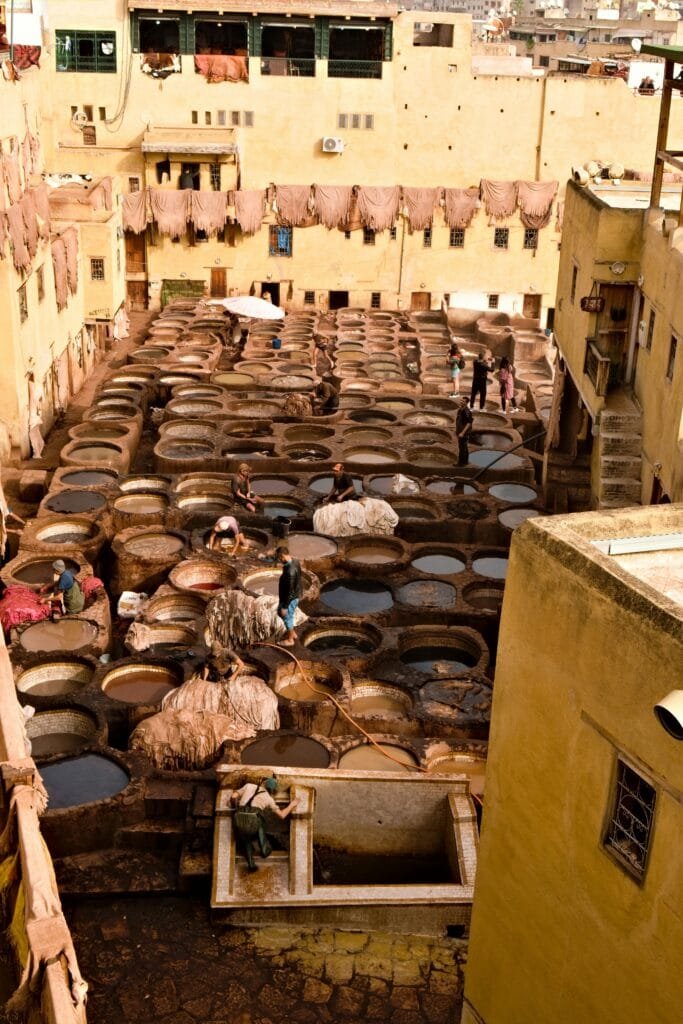
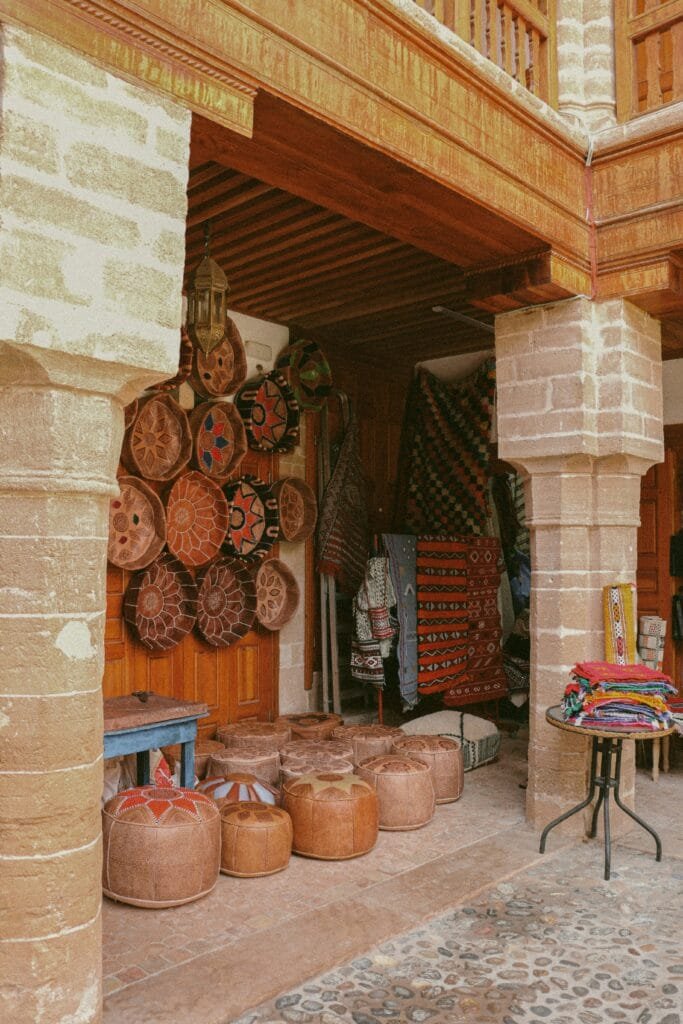


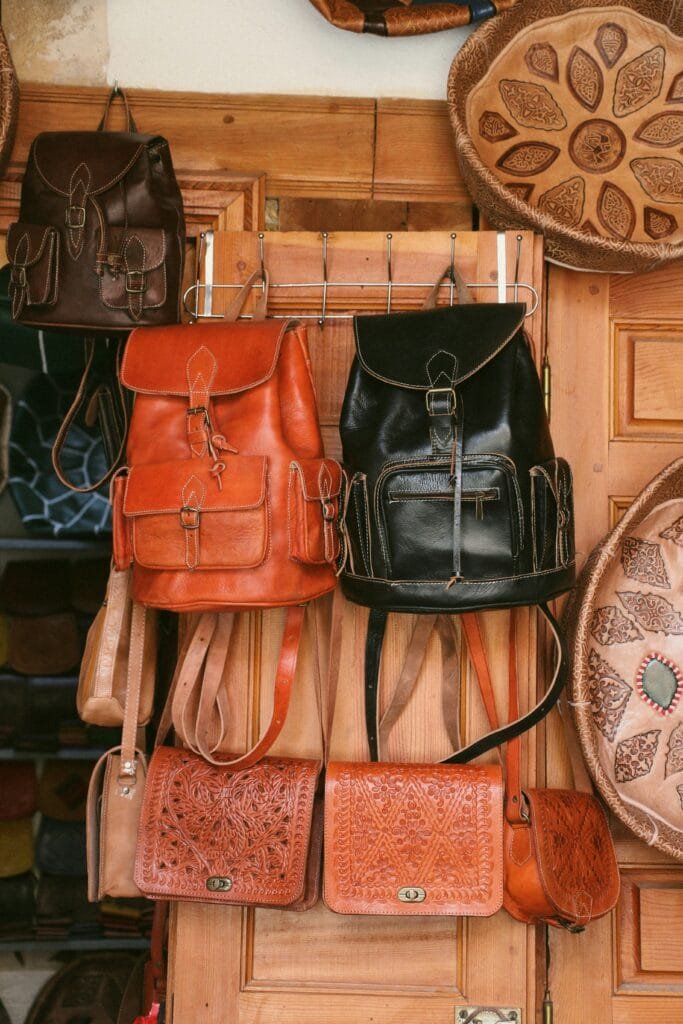
2. Zellige Artisans – The Geometry of Tradition
Get ready to be amazed by Zellige. This art is a key part of Morocco’s culture. In Fez, you’ll find talented masters still dedicated to this detailed craft.
Imagine a Zellige artisan. They focus intently as their hands expertly cut and shape tiny glazed tiles. Each tiny piece is managed with precision. This shows their strong grasp of geometry and design. These simple pieces are the basis for stunning geometric patterns. They decorate the important architectural wonders of Fez. You can find them in quiet mosque courtyards, madrasa classrooms, palace rooms, cool fountains, and cozy homes.
Picture these skilled craftsmen using simple tools. In their hands, these tools turn into extensions of their creativity. Making Zellige requires great patience, focus, and artistic skill. Each design is like a complex puzzle. It needs the smooth integration of hundreds, or even thousands, of hand-cut tiles. It’s a testament to their ability to visualize the final masterpiece within the multitude of individual pieces.
The magic of Zellige lies not only in its visual beauty but also in the profound dedication of the artisans who bring it to life:
- A Testament to Human Skill: Every single piece of Zellige is a product of the human hand. There are no machines involved, only the pure skill, dexterity, and inherited knowledge of the artisan. This makes each Zellige panel a unique work of art, imbued with the spirit of its creator.
- Zellige: A Blend of Spirituality and Math. Zellige shows the unique beauty and deep meaning of Islamic art. The intricate geometric patterns show a strong grasp of math concepts. They also connect deeply to a divine order. This creates harmony and invites contemplation.
- A Legacy Preserved Tile by Tile: This remarkable craft is not just a profession; it’s a legacy passed down through generations. Every artisan upholds Moroccan heritage. They make sure this beautiful art form thrives, one carefully placed tile at a time.
- More Than Decoration, a Labor of Love: When you look at a Zellige panel, you see years of hard work and centuries of skill. Each tile speaks of the artisan’s commitment, their passion for their craft, and their deep connection to the artistic soul of Fez. Prepare to be moved by the sheer artistry and dedication that breathe life into this timeless Moroccan art form.
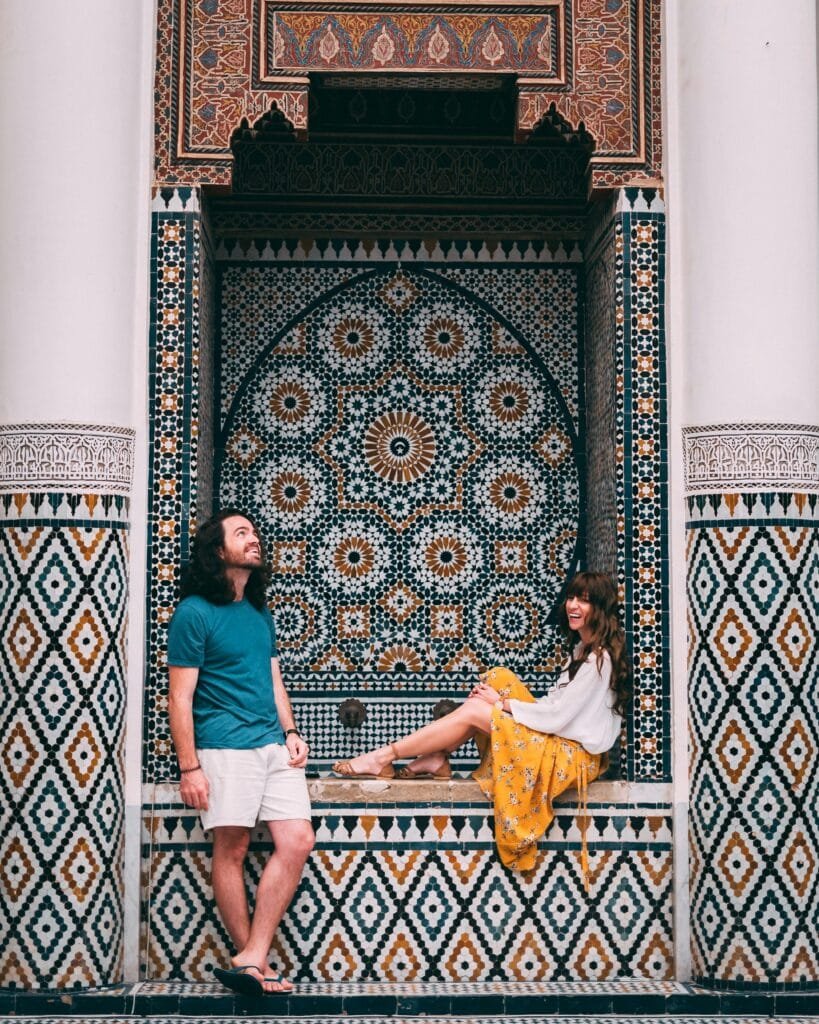



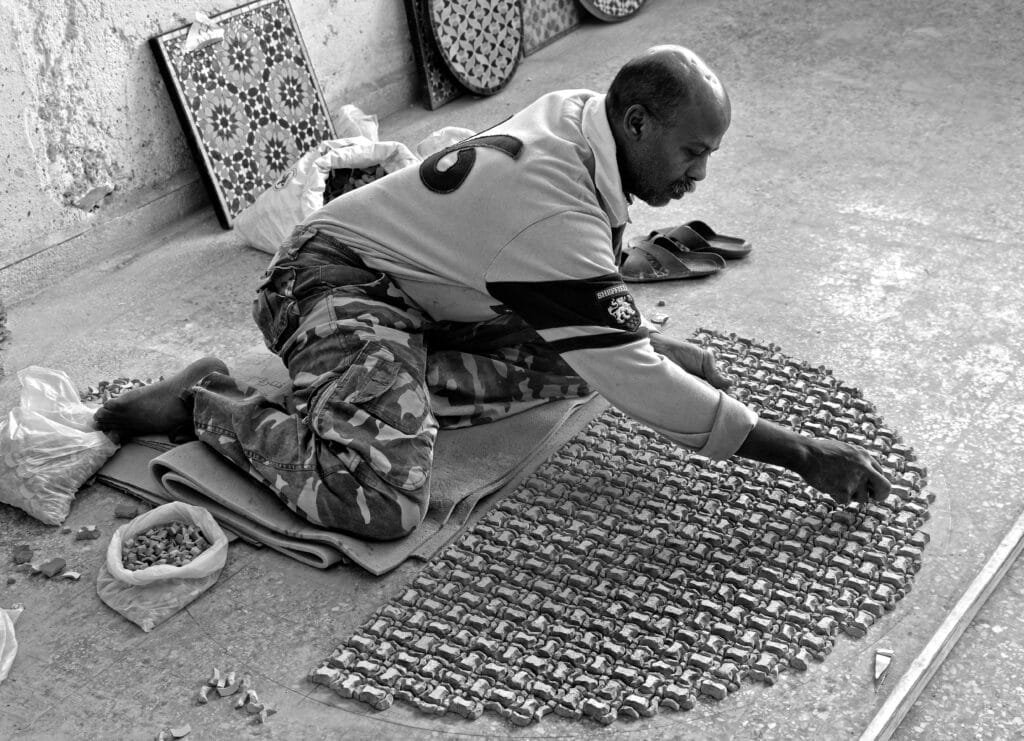
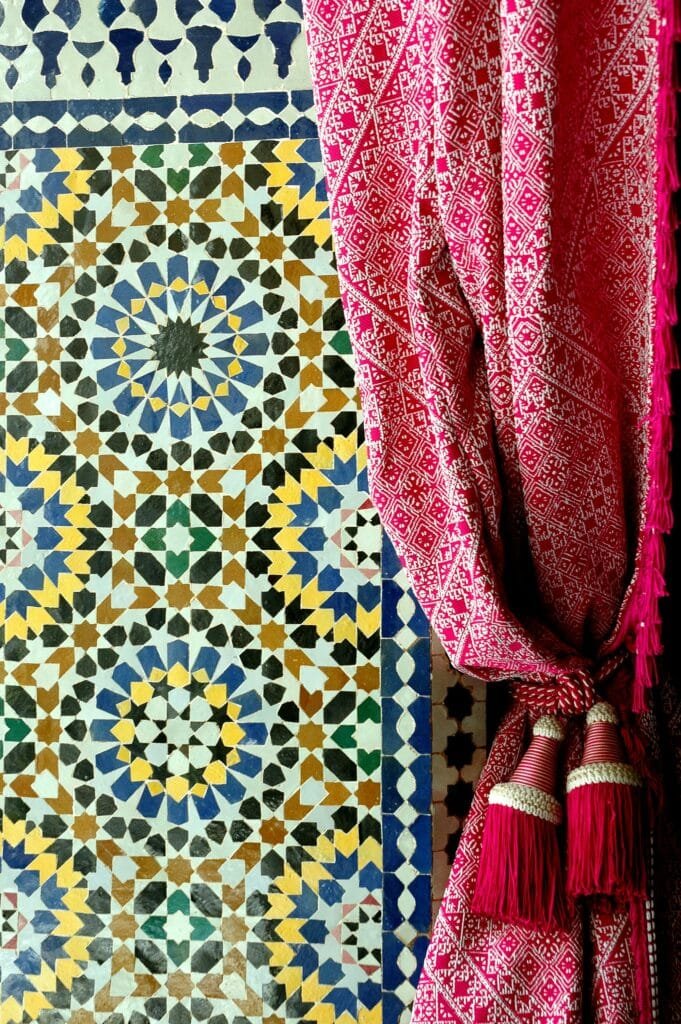
3. Brass and Copper Engraving – The Voice of Metal in Fez
Explore the winding alleys of Fez, especially near Nejjarine Square. Listen as skilled artisans shape metal with a rhythmic beat. Discover the timeless art of brass and copper engraving. This age-old craft is kept alive by skilled artisans who turn simple metal into beautiful, functional pieces.
Imagine the sharp focus of these craftsmen. They swing hammers and chisels, their skills shaped by years of practice. Each careful strike reveals beautiful designs on trays, teapots, lamps, and decorative pieces. These will enhance tables, pour fragrant mint tea, cast warm glows, and brighten homes. Each curve and line is carefully engraved by hand. The designs often take inspiration from classic geometric patterns and the charm of Moroccan floral motifs.
Witness the mesmerizing dance between the artisan and the metal:
- A Symphony of Precision and Patience: Observe the incredible precision with which each detail is manually carved. It’s a process that needs a good grasp of the metal’s properties. You also need a natural sense of rhythm. Plus, you must strike with the right amount of pressure each time.
- More Than Souvenirs, Vessels of Culture: These handmade items are not just souvenirs. They are real pieces of Morocco’s rich heritage and culture. Owning one is like holding a piece of Fez’s history in your hands.
- Timeless Elegance, Admired Worldwide: Fez’s copper and brass pieces are stunning and well-crafted. Their charm crosses borders. They are admired locally for their usefulness and beauty. Internationally, they are seen as stunning examples of traditional Moroccan art.
- A Dance of Strength and Skill: Watching these artisans is like seeing a ballet of strength and precision. It’s a living tradition. It shows human skill. Metal, once unyielding, finds its voice in beauty and artistry. Allow yourself to be mesmerized by the transformative power of their hands and the enduring allure of their creations.
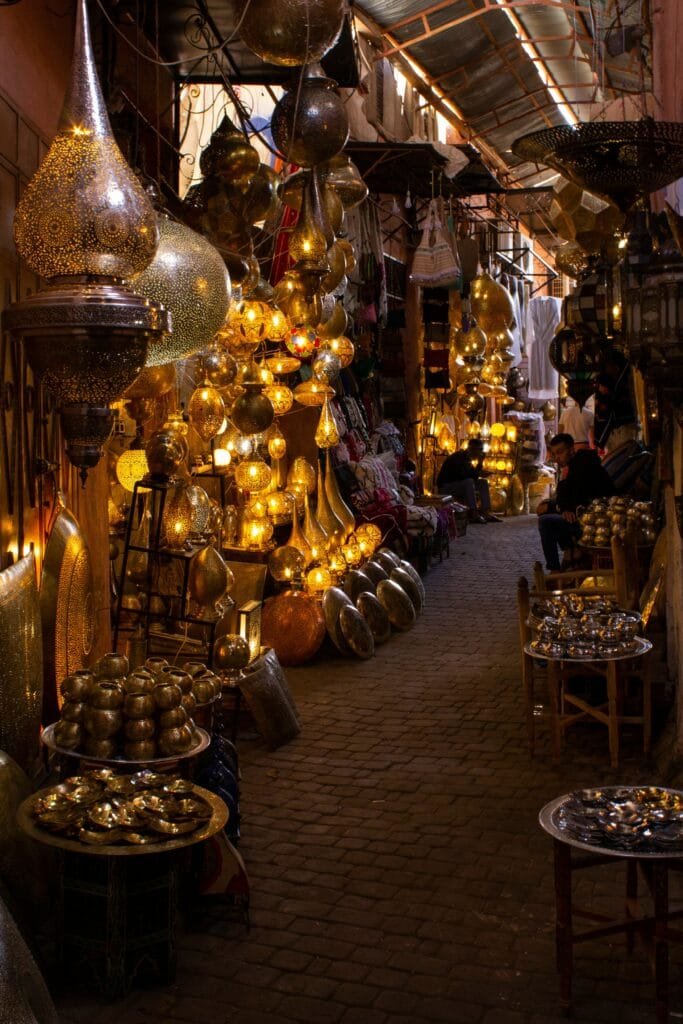
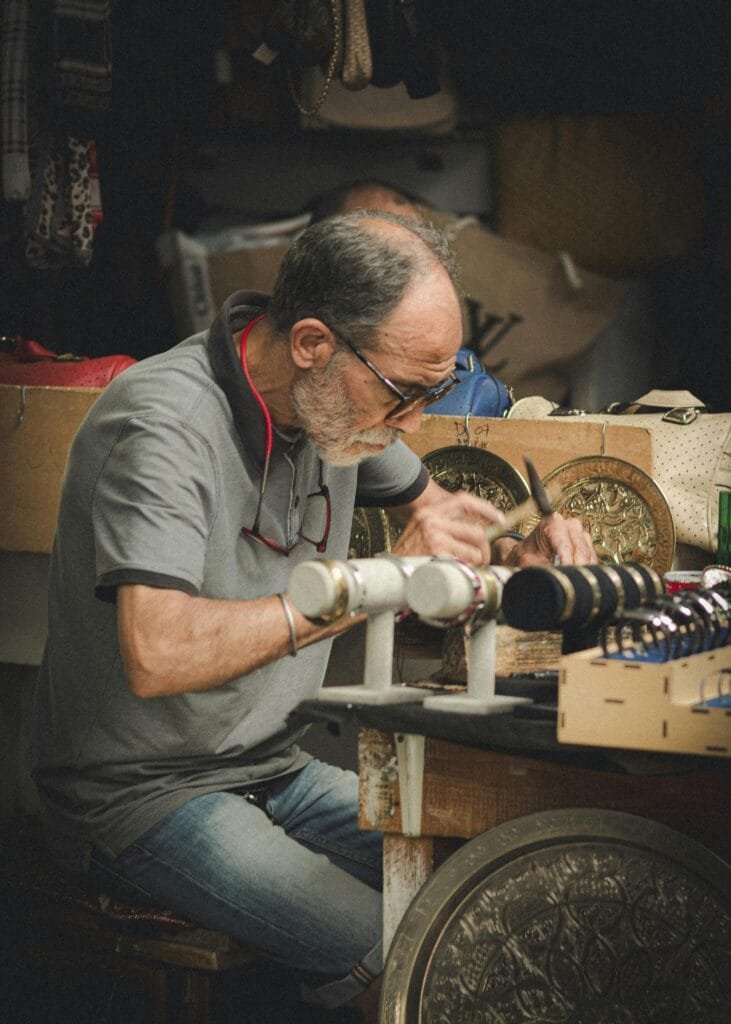
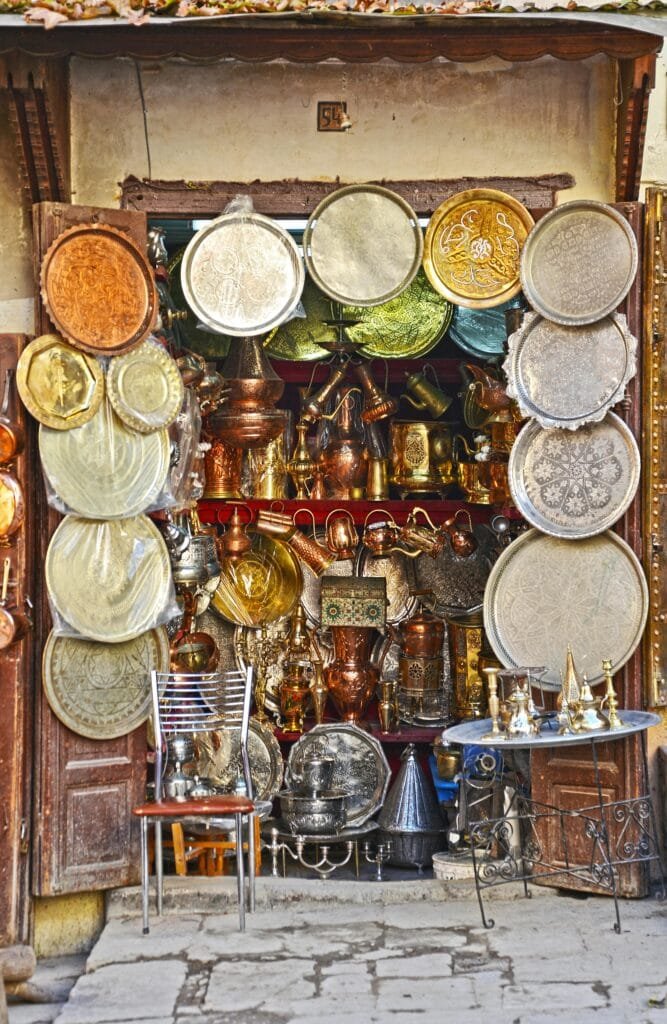
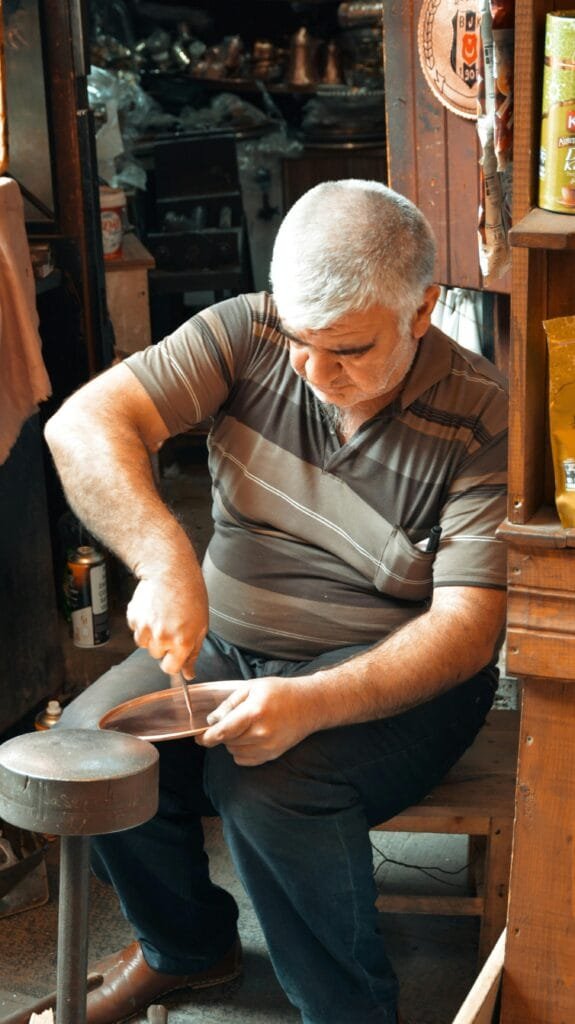
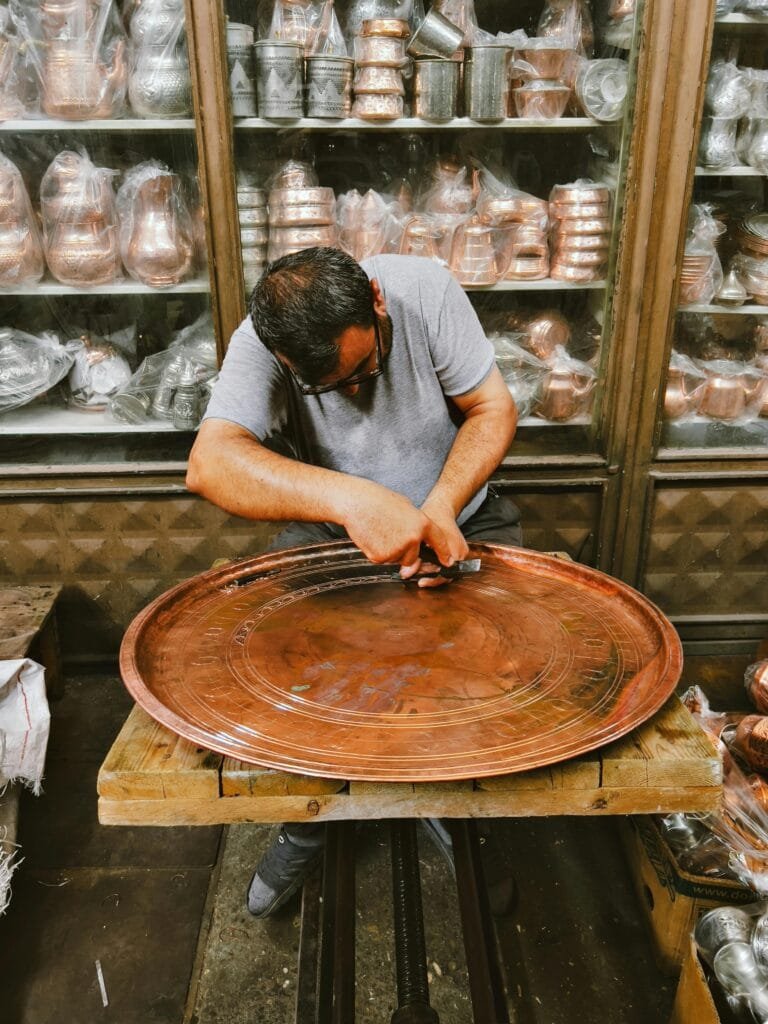
4. Wood Carving – The Soul of Moroccan Architecture
Get ready to be amazed by wood carving. This art form is a key part of Moroccan culture, especially in Fez, where it is highly valued. Master woodcarvers use their skilled hands and keen eyes to change simple cedarwood into stunning pieces. They create intricate geometric patterns and flowing arabesque designs. These stunning creations enhance Fezzi architecture and design. They adorn impressive doors that welcome you, high ceilings that inspire awe, elegant window screens that let in light, and chic Moroccan furniture that adds charm and warmth to every room.
Imagine the dedication and years of rigorous training required to master this delicate art. Each carved panel is a testament to the artisan’s profound eye for detail and their deep understanding of the wood itself. Each carving is more than decoration. It tells a silent story. These stories reflect spiritual harmony, mathematical balance, and the deep beauty of Islamic art. In a mosque, a palace, or a riad, carved woodwork brings warmth, beauty, and cultural richness. Its intricate designs enhance the serene ambiance and create a welcoming atmosphere.
The allure of Fez’s wood carving tradition lies in several key aspects:
- A Legacy of Timeless Skill: Every exquisite piece is brought to life entirely by hand. These artisans use simple tools, but they have deep knowledge and experience. Their skills come from hard work and an understanding of their craft passed down through generations.
- A Symbol of Prestige and Refinement: In Moroccan culture, fine woodwork reflects nobility and elegance. It speaks to a tradition of valuing artistry and craftsmanship in the highest regard.
- A Living Act of Cultural Preservation: This art form lives on thanks to the artisans’ dedication. They pass down this important part of Moroccan heritage from master to apprentice. This way, it survives and thrives, adding to the culture of Fez and beyond.
Let the carved wood in Fez enchant you. It shows the lasting strength of human skill, artistic vision, and the deep beauty of tradition.
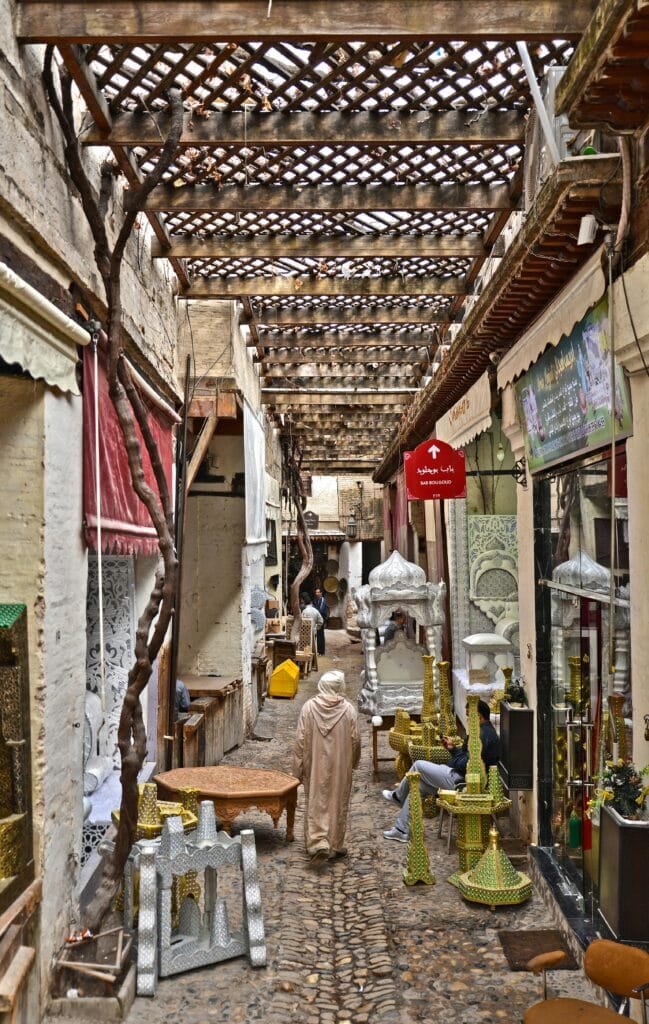
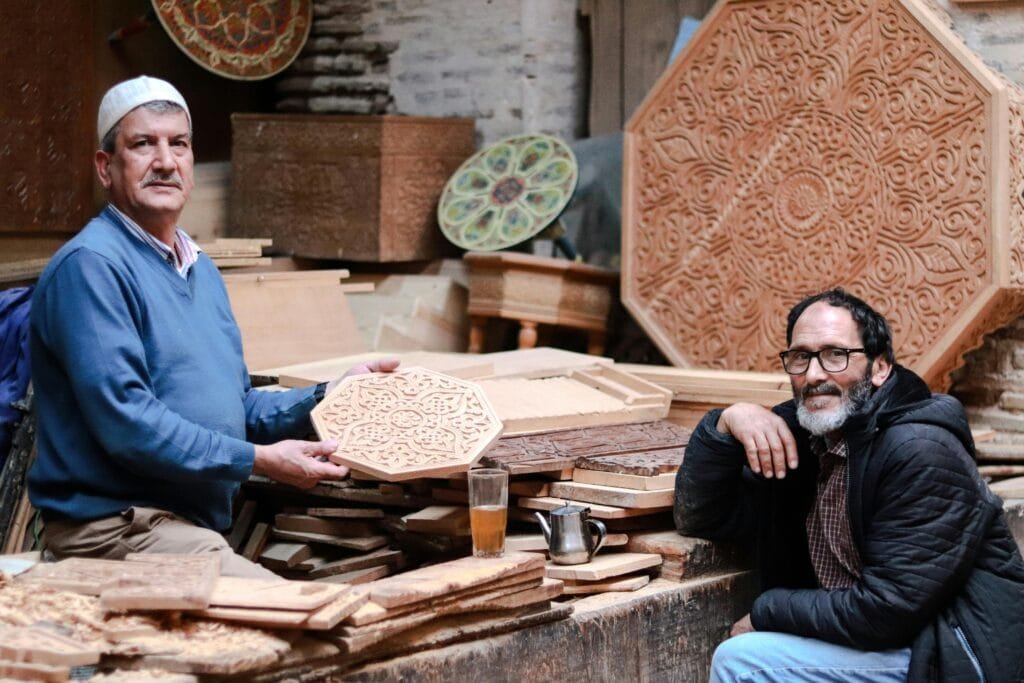


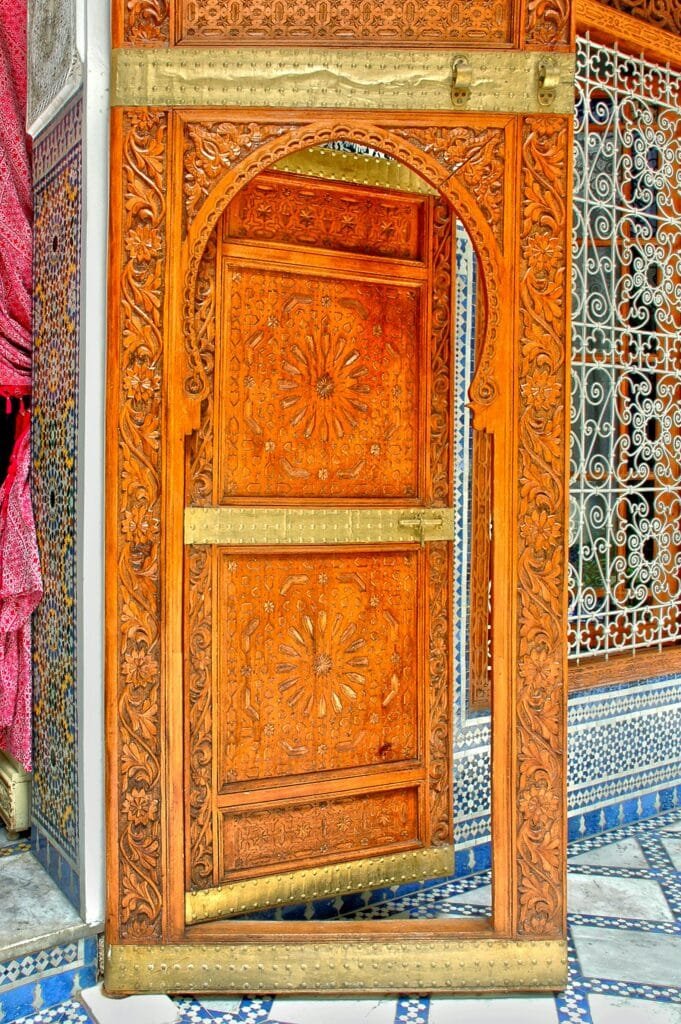
5. Fez Embroidery – Silk Threads of Elegance
Prepare yourself to be amazed by Fez embroidery. This art shows the beauty and skill of Moroccan crafts! Picture silken threads, glowing in deep blues or bright colors. Skilled artisans guide them, creating intricate designs with great care and beauty. Welcome to the beautiful world of Fez embroidery. This craft is done entirely by hand. Each stitch shows great artistry and patience.
This beautiful art form enhances traditional Moroccan clothing. It adorns flowing caftans and dignified jellabas, adding timeless elegance. It also adds beauty to home textiles. Pillowcases, curtains, and tablecloths can be simple or stunning. They reflect centuries of cultural heritage. Every design in the fabric shows the grace and patience of the women who have mastered this delicate art.
The significance of Fez embroidery lies in several remarkable aspects:
- Unmatched Precision: A Sign of Real Skill: Fez embroidery is famous for its unique single-faced technique. Creating such detailed patterns on the front of the fabric, while keeping the back clean, shows real skill. It highlights mastery and careful work.
- It speaks of a deep appreciation for beauty and tradition, elevating the ordinary to the extraordinary.
- A Treasured Heritage, Thread by Thread: This traditional skill passes from mother to daughter. It shows the strong bond of family and the value of heritage. Fez embroidery is passed down through generations. This keeps the art and techniques alive, preserving this valuable cultural treasure.
When you see the beauty of Fez embroidery, pause to appreciate the hours of work and the rich culture in every silken thread. It is a visual poetry, a testament to the enduring artistry and grace that flourishes within the heart of Fez.

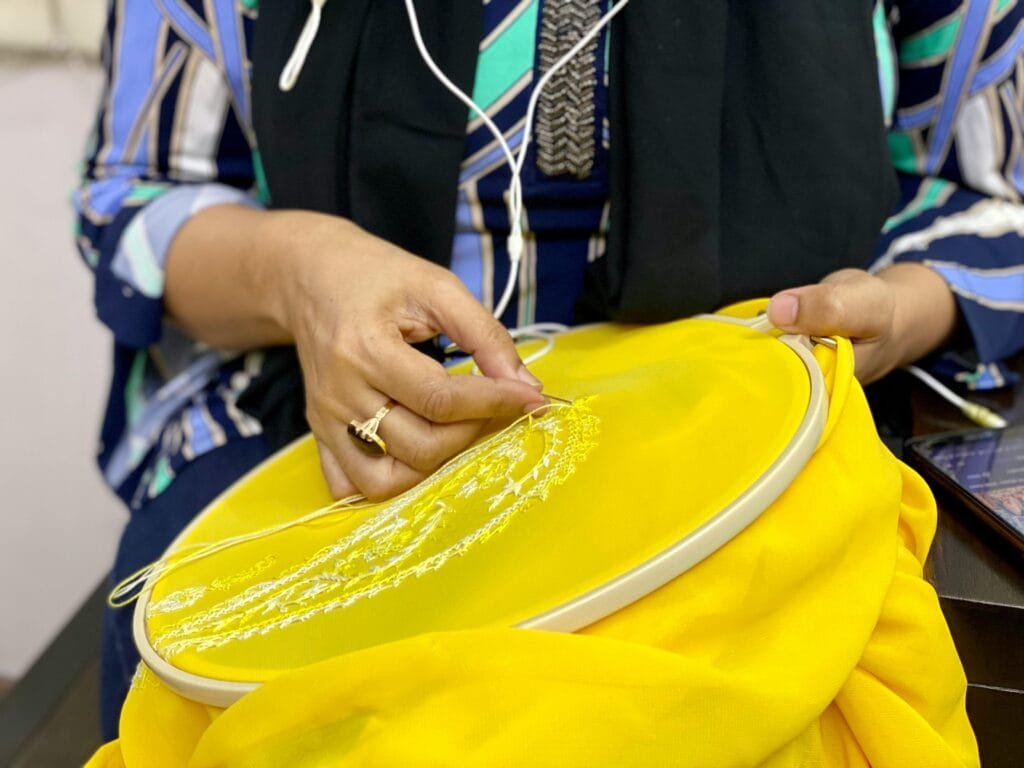


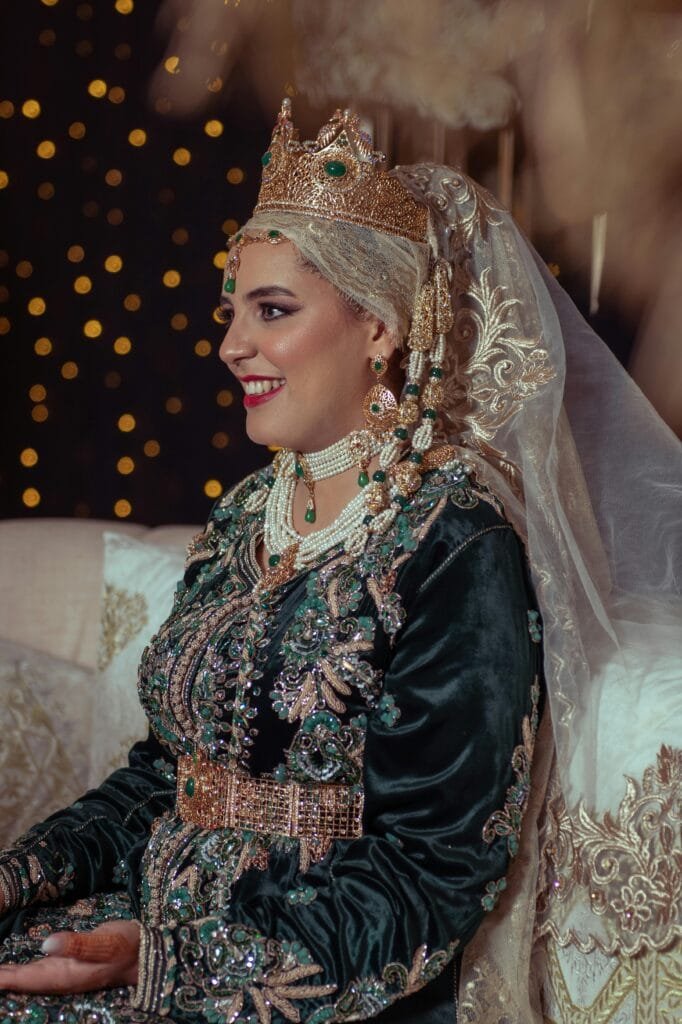

6. The Artisans of Seffarine Square – Masters of Living Tradition
Seffarine Square! Get ready to dive into Fez’s rich artisanal spirit. Here, the sound of hammers on metal carries centuries of tradition. Located by the famous Qarawiyyin Mosque in the old medina, this lively square is a center for the city’s top traditional artisans. They are the true masters of their crafts.
Step onto Seffarine Square and listen to the rhythmic clang of metal. It’s a reminder of the craftsmen who shaped their lives and the city’s artistic spirit here. Here, amidst the bustling energy, you’ll encounter:
The Esteemed Coppersmiths (Saffarine):
The very name of the square pays homage to these foundational artisans. See their amazing skill as they shape and engrave copper and brass into many beautiful and useful items. They make patterned trays that show hospitality. They also create elegant teapots for mint tea. Charming lanterns add a warm glow, and sturdy bowls have been used for generations. Their techniques are not learned from books, but passed down directly from father to son, a living lineage of craftsmanship.
The Delicate Metal Engravers:
Watch the skilled metal engravers as they create beautiful patterns and flowing letters on copper and brass pieces. They carefully change everyday items into art. Each line and curve shares a story of tradition and beauty. Their hands possess the skill to imbue metal with a soul.
The Reverent Bookbinders and Quran Restorers:
Near Seffarine Square and the well-known Qarawiyyin Library, skilled bookbinders and Quran restorers work quietly. These guardians of knowledge practice bookbinding. They carefully repair fragile ancient manuscripts and restore sacred texts with deep care and respect. Their work is a testament to Fez’s enduring legacy as a center of learning and spiritual wisdom.
A visit to Seffarine Square offers an invaluable glimpse into the authentic heart of Fez:
- Witnessing Living Tradition: This is not a staged performance for tourists; it is the vibrant reality of daily life for these artisans. You’ll witness the dedication, skill, and techniques that have kept these crafts alive for centuries.
- Support the Keepers of Culture: When you buy authentic handmade souvenirs from artisans, you get a beautiful item. You also help keep important cultural traditions alive and support the lives of those who create them.
- Connecting with Fez’s Soul: Seffarine Square shows how knowledge and craft blend in Fez. The artisans are close to the historic Qarawiyyin Library. This shows the city’s respect for both intellectual and manual skills. Here, tool-making and book preservation thrive together.
More than just a visual experience, visiting Seffarine Square is an opportunity to truly connect with the soul of Fez. It’s about hearing traditions echo, feeling history in artisan hands, and seeing the spirit of this amazing city.




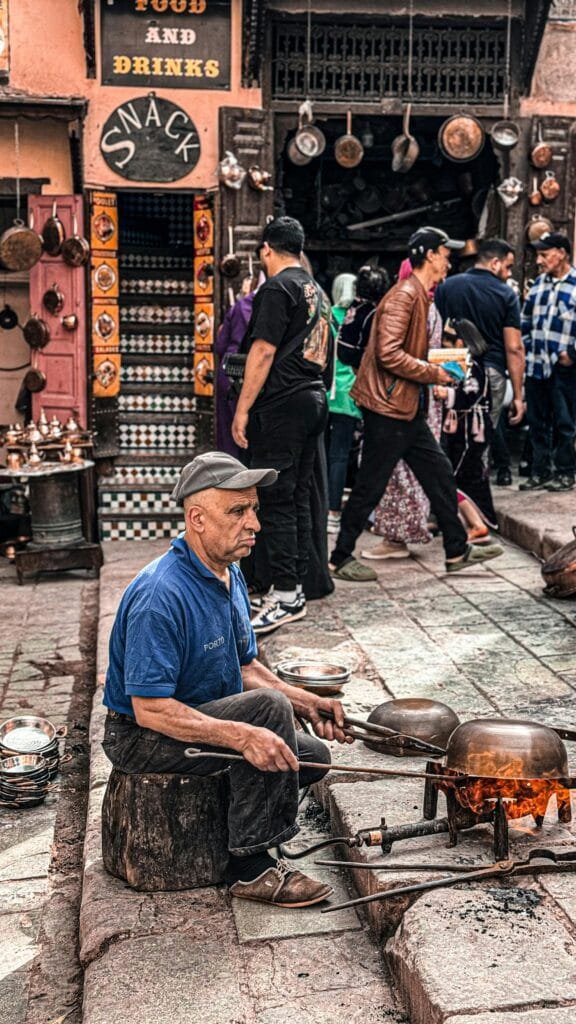
7. Leather Artisans of Fez – Masters of Handmade Bags and Accessories
Get ready to be amazed by the skill of Fez’s leather artisans. They are the true masters of handmade bags and accessories. You’ll find their work in the heart of the medina, especially near the famous tanneries and busy leather souks. Skilled craftsmen proudly transform naturally tanned leather from Fez’s famous tanneries. This leather has a rich character and becomes a high-quality, durable, and stylish item.
Picture these artisans at work. Their hands cut, stitch, and assemble each piece with great care. They use traditional tools and time-tested techniques. This focus on handcraftsmanship makes each bag, backpack, wallet, and accessory unique. Each piece shows the personal touch of its maker.
You’ll find a great mix of designs. Some are timeless classics and vintage styles that hint at Moroccan heritage. Others are modern and full of vibrant energy. You’ll often see bold Berber patterns, meaningful embossed designs, and rich colors from natural dyes. These elements add a unique cultural touch to every piece.
Here’s why the creations of these leather artisans are so special:
- Unwavering Authenticity: These are not mass-produced items churned out in factories. Every bag and accessory shows real artisanal skill. They reflect the craftsman’s dedication and passion.
- A Tangible Link to Moroccan Culture: When you buy from these artisans, you get more than a beautiful item. You support local heritage and own a piece of living Moroccan tradition, filled with the spirit of Fez.
- Top Quality and Lasting Style: Fez leather is known for its softness, strength, and stunning natural texture. These traits and expert craftsmanship create accessories that are durable and always elegant.
- An Immersive Experience Awaits: For a truly enriching experience, be sure to visit the leather workshops. You can see the whole fascinating process up close. It starts with tanning and ends with careful stitching.
Explore the stunning work of Fez’s leather artisans. Take home more than an accessory; bring a piece of the city’s rich craftsmanship and culture.
Generate Audio Overview


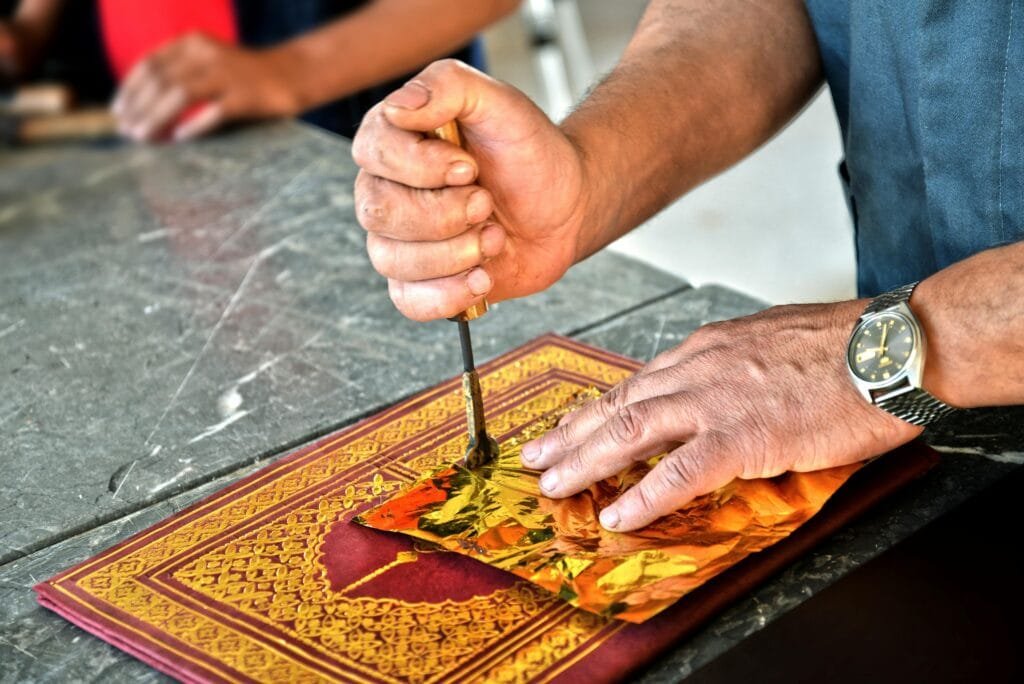
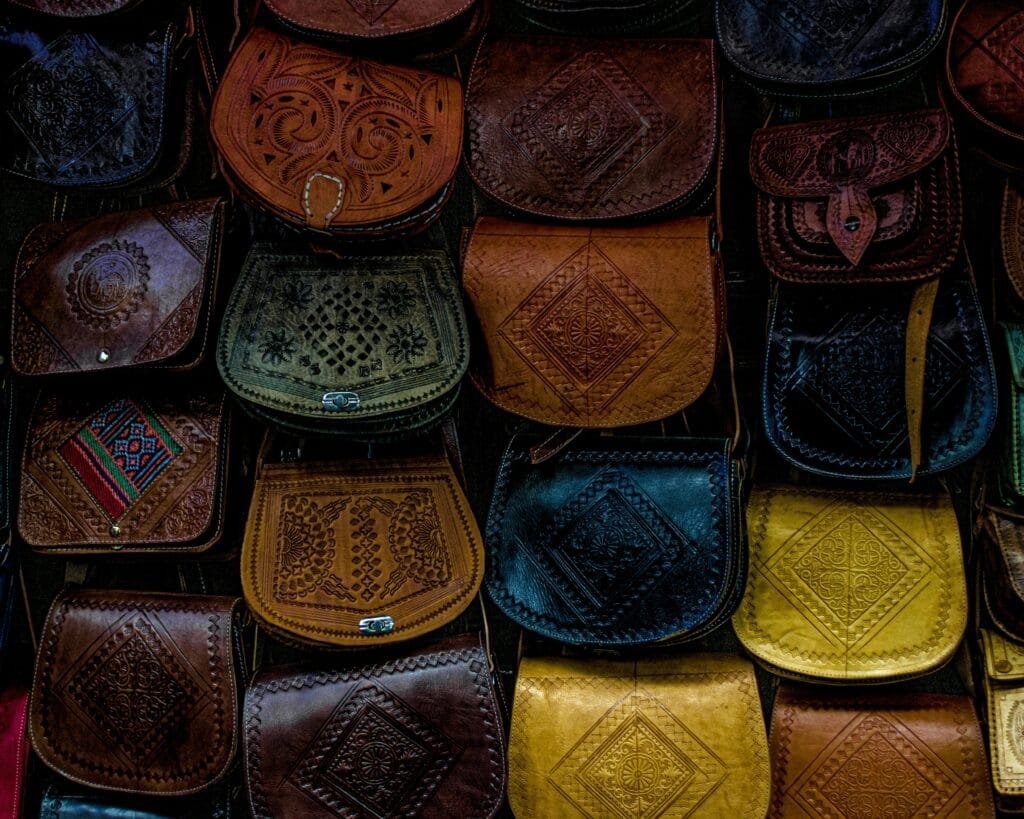
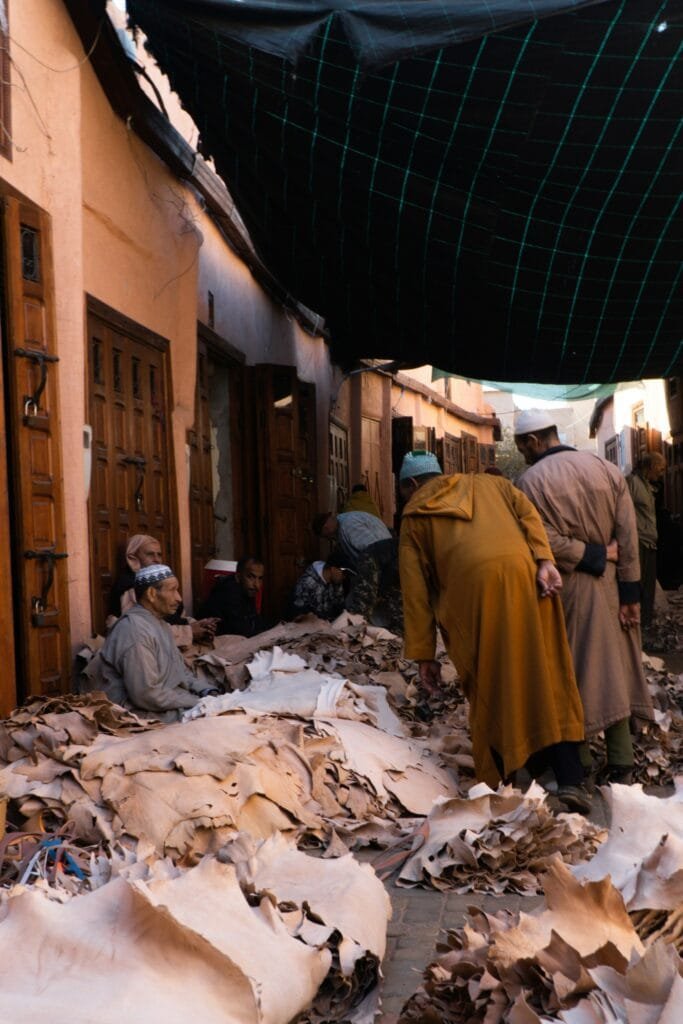
8. Traditional Shoemakers – The “Kharrazine” of Fez
Ahlan wa sahlan to the captivating world of Fez, where ancient traditions come alive with every step! As you explore the winding alleys of our beautiful medina, you’ll reach the lively Qissariat Al-Kifah. Here, near the fragrant Attarine district, you’ll find the heart of Moroccan craftsmanship. Look for the Kharrazine, our traditional leather shoemakers.
The Kharrazine are not just artisans; they are guardians of a rich legacy. Their skilled hands turn soft leather into beautiful shoes. These shoes are worn by Moroccans for every occasion. They create the iconic balgha, which is an elegant leather slipper seen everywhere. They also make the cherbil, a stylish shoe loved by Moroccan women.
Imagine: each pair you see is a testament to centuries of skill, meticulously handcrafted without the aid of modern machinery. Feel the luxurious softness of the leather, often dyed with natural pigments that whisper tales of the earth. Admire the vibrant hues of the fabrics and the intricate stitching that adds a touch of artistry to every piece.
But what truly makes these shoes extraordinary?
- A Touch of the Soul: Forget mass-produced uniformity. Every pair of Kharrazine creations has its own special character. They show the unique touch of the artisan who crafted them with care and skill. You are not just buying shoes; you are acquiring a piece of Moroccan artistry.
- Woven into Our Identity: These are not mere accessories; they are vibrant threads in the rich tapestry of Moroccan culture. These shoes symbolize our heritage and elegance. They connect us to our traditions, from joyful celebrations to solemn weddings and everyday life. Wearing them is embracing a piece of Moroccan identity.
- Nature’s Embrace: We choose only the best leather, often dyed with natural colors. This ensures great comfort and lasting quality. These are shoes designed not just to look beautiful, but to feel exquisite and last through time, becoming a cherished part of your own story.
Your Journey to Discovery:
To truly immerse yourself in this captivating craft, make your way to the Qissariat Al-Kifah (Victory Market). Here, within this traditional covered souk, a treasure trove awaits. Small stalls overflow with beautiful handmade Moroccan slippers. They range from simple designs to fancy, ornate styles.
A Tip for the Curious Traveler:
Don’t just let your eyes feast on the beauty before you – engage with the artisans! They are often delighted to share their craft, custom-fit a pair just for you, or even offer a glimpse into the intricate process of creation. Owning a pair of authentic Moroccan balgha is more than just getting a stylish souvenir. It connects you to the living heritage of Fez. Each pair serves as a reminder of the artistry and soul found within its ancient walls. Walk away with a piece of our story, ready to create your own.
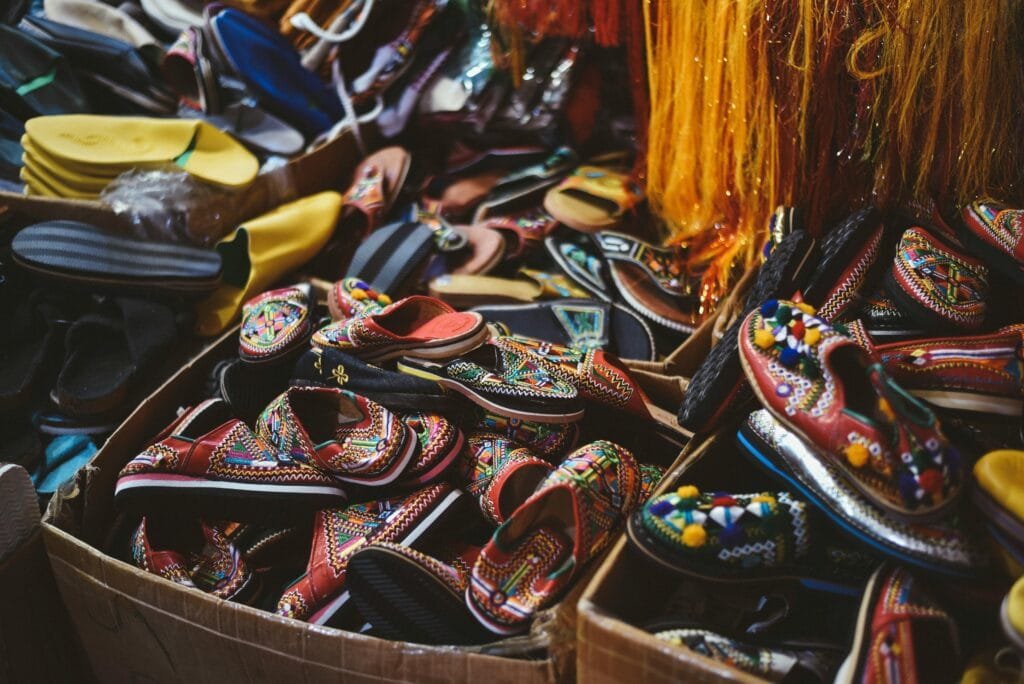
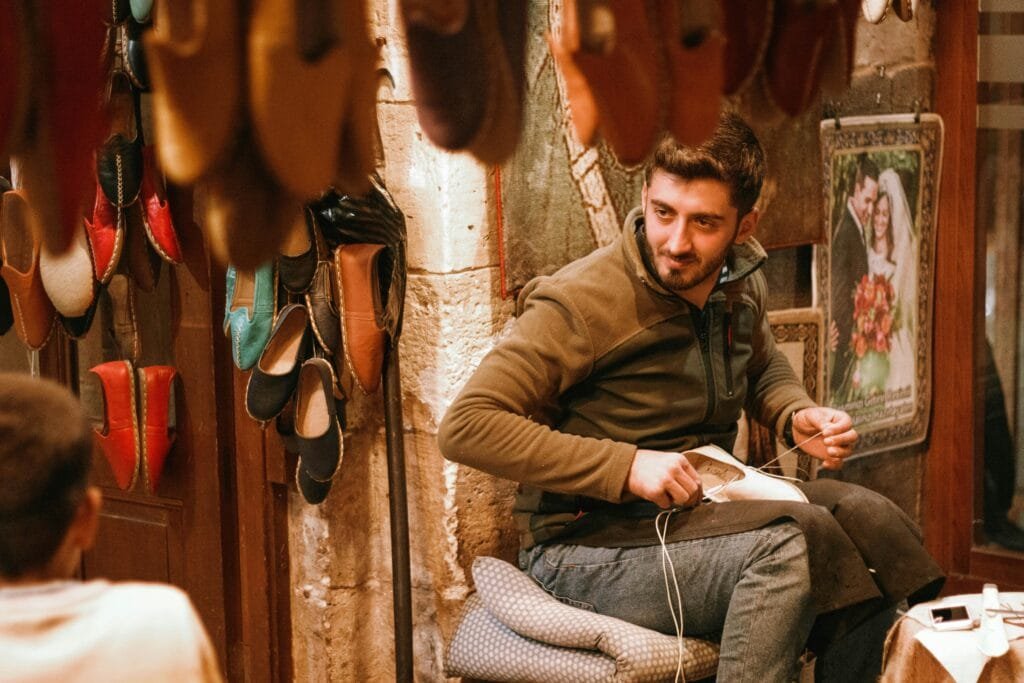
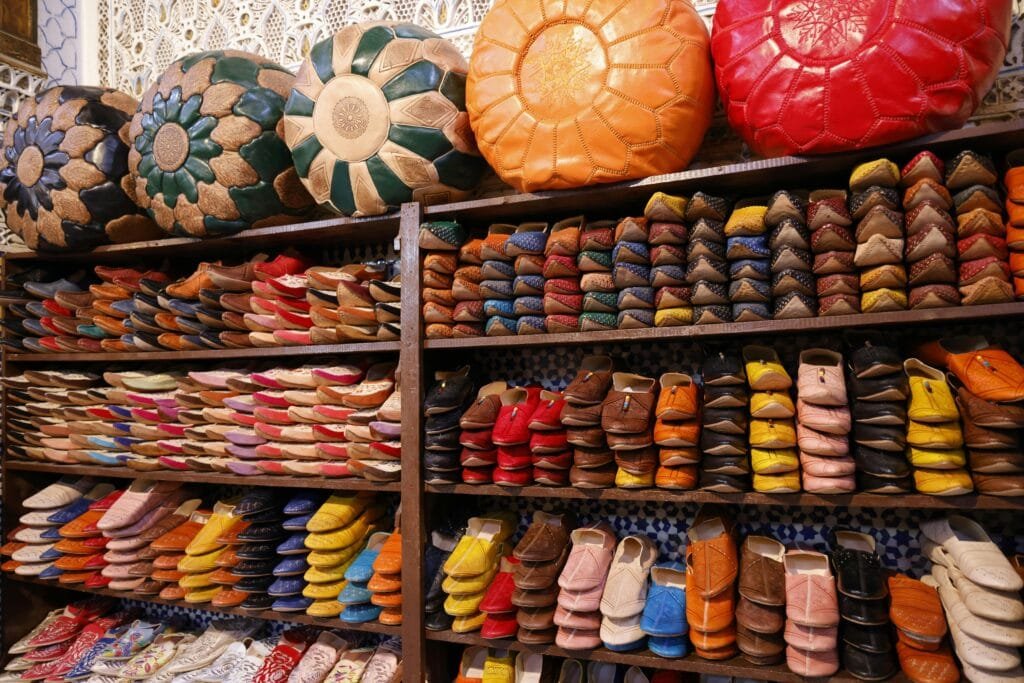
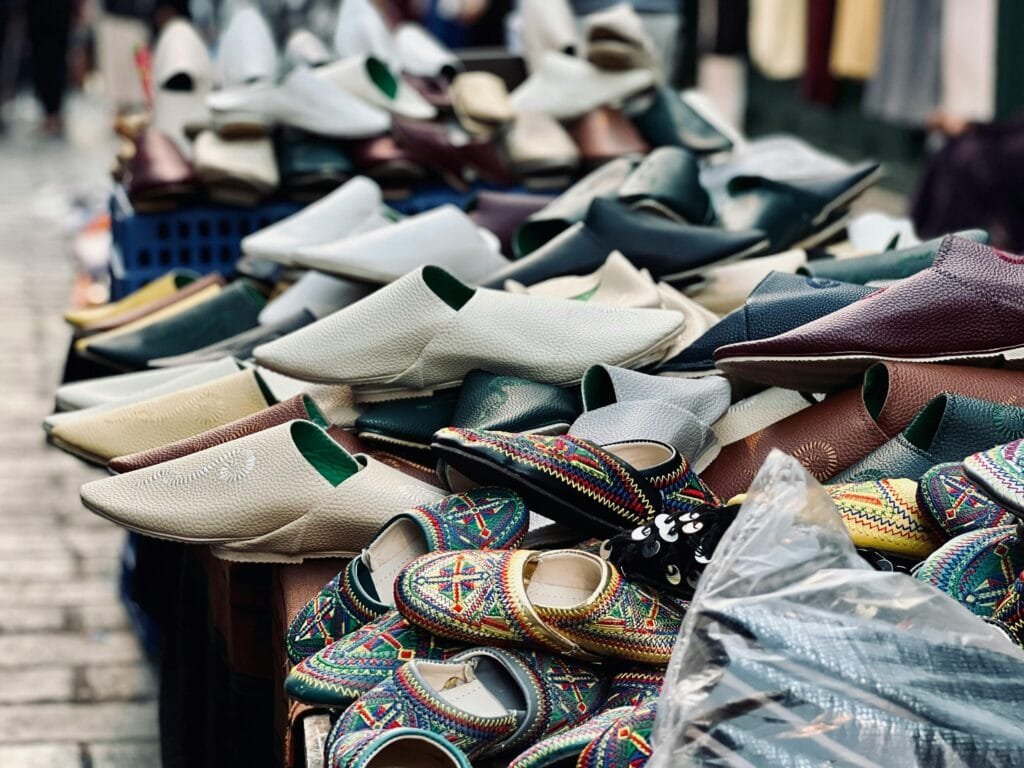

9. Beyond the Famous Crafts – A City of Countless Skills
Beyond the famous leatherwork, you will find more wonders, dear travelers. The heart of Fez pulses with many ancient crafts. Each craft is a vital part of our rich heritage. The iconic slippers and ornate footwear catch your eye. But if you look closer, you’ll find a city that is a living museum of craftsmanship. Every corner tells stories of artistry passed down through generations.
Picture the warm smell coming from the old Ferrane. It’s where bakers make fresh bread every day. Experience the lovely tradition of locals bringing their dough to the baker. They trust the baker’s skill and the warmth of the wood-fired flames. This ritual feeds the body and strengthens community ties, honoring our ancestors.
Next, find the delicate work of the Horn Combers. They turn simple animal horns into beautifully carved combs and special decorative items. Notice the skill and care needed for this disappearing art. It shows our craftspeople’s creativity in making beauty and usefulness from natural materials.
Experience the heat and hear the metal clang in the Knife Makers‘ workshops. Here, skilled hands create and sharpen custom blades for daily tasks and special ceremonies. Each knife carries the mark of the artisan, a blend of functionality and tradition.
Lose yourself in the vibrant colors and intricate patterns emerging from the looms of Weavers and Rug Makers. See the beautiful dance of threads turning into amazing fabrics and hand-knotted carpets. They are dyed in nature’s rich colors and rooted in the ancient traditions of Amazigh and Arab cultures. These are not just textiles; they are stories woven in wool.
Finally, watch the Pottery Designers. They skillfully shape and paint clay with grace and precision. From the everyday beauty of hand-painted dishes to the intricate artistry of decorative tiles that adorn our homes and mosques, their creations bring the very earth to life.
These glimpses are but a few of the countless treasures you will uncover as you meander through the labyrinthine alleys of our medina. With every turn, a new scent – the rich aroma of leather, the fragrant blend of spices – and a new sound – the rhythmic tap of a hammer, the whir of a loom – will greet you. Fez is more than just a city of magnificent monuments; it is a vibrant, breathing testament to the enduring power and beauty of human craftsmanship, waiting to be explored and appreciated. Come, and let your senses be your guide to the soul of our city.
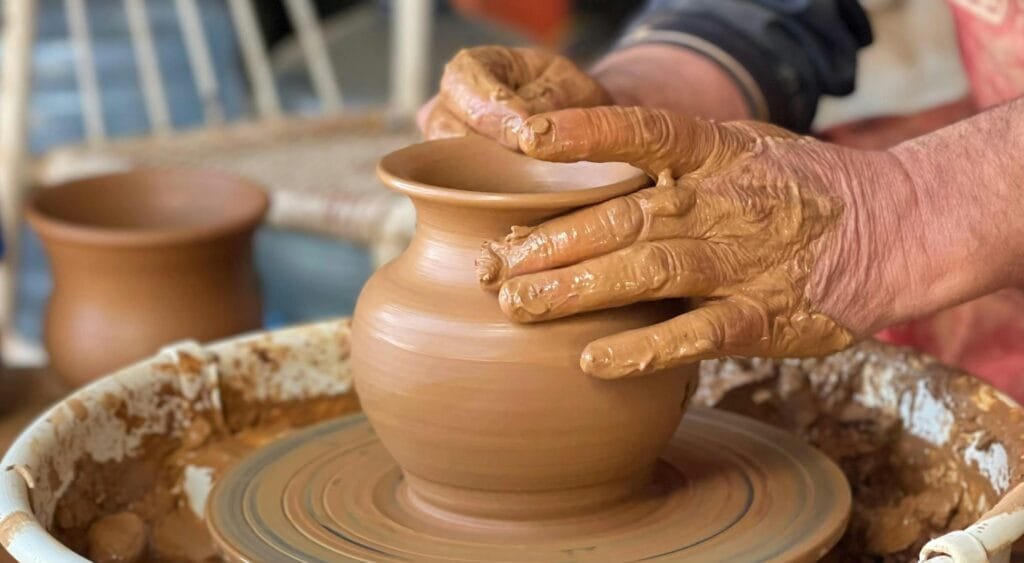


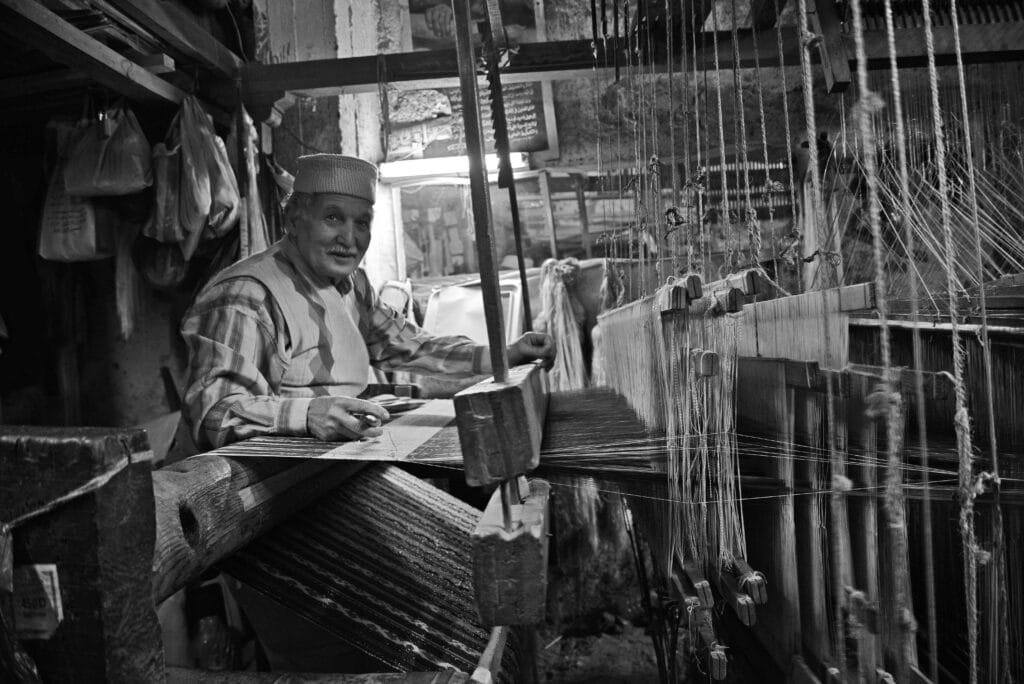
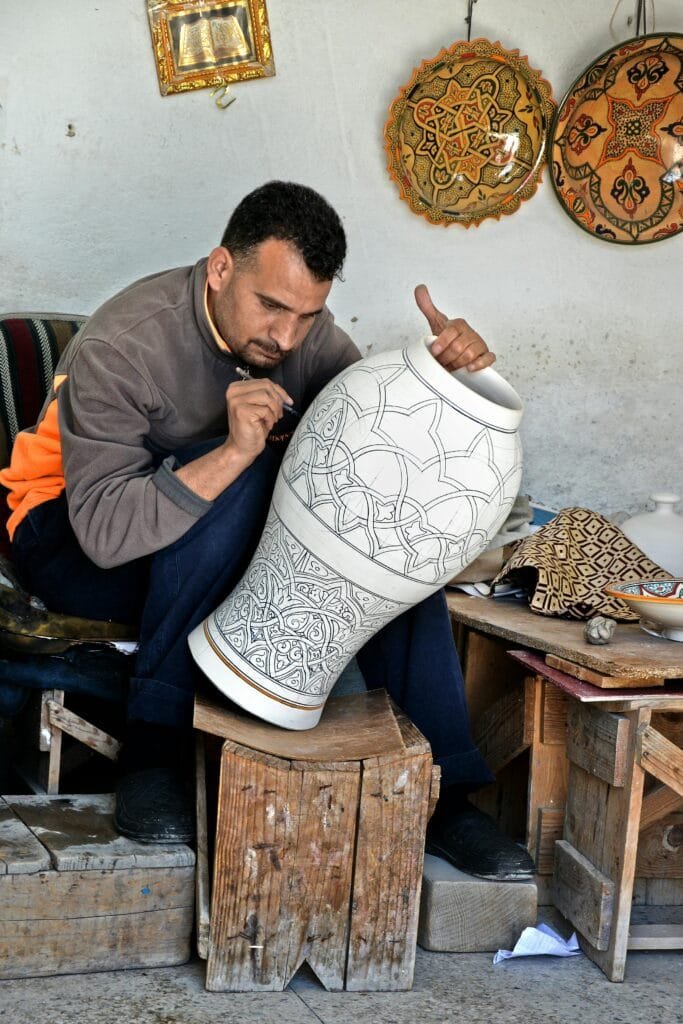
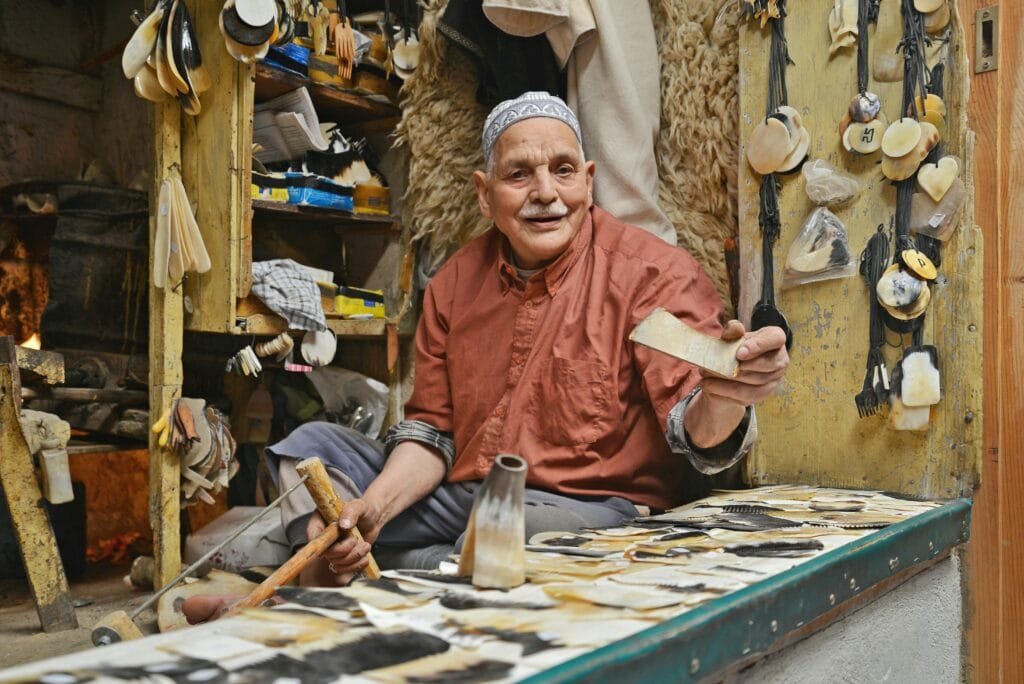
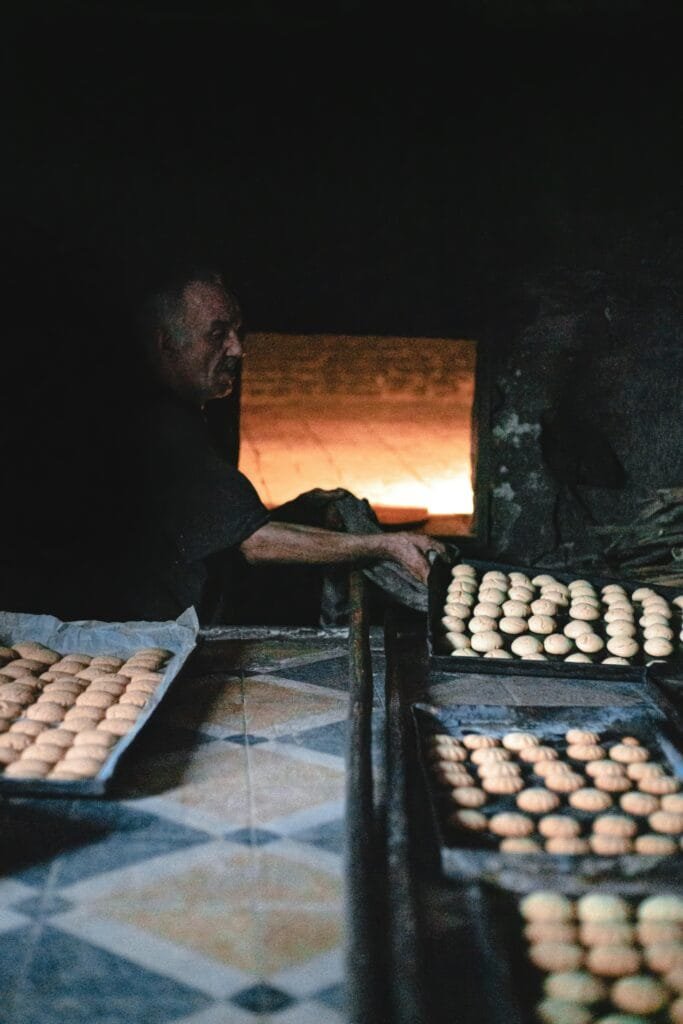
summary
Fez, a city that whispers tales of bygone eras through its breathtaking Islamic architecture and profound spiritual heritage – home to the venerable Al-Qarawiyyin University, the intricate beauty of the Bou Inania and Attarine Madrasas, the timeless charm of Nejjarine Square, and the rhythmic pulse of Seffarine Plaza. But beyond these magnificent stones lies another treasure, equally precious and deeply intertwined with the city’s soul: centuries-old artisanal traditions that continue to breathe life into its ancient heart.
As you lose yourself in the embrace of Fez’s labyrinthine alleys, prepare to encounter a world where time seems to slow down, where the legacy of generations is etched in every handcrafted piece. You will witness the skilled hands of leather artisans transforming raw hides into supple masterpieces, the intricate artistry of brass engravers adorning metal with mesmerizing patterns, the meticulous precision of zellige (tile) masters crafting kaleidoscopic mosaics, the patient dedication of wood carvers bringing intricate designs to life, and the delicate artistry of embroidery artists weaving vibrant stories in thread.
Wander through the legendary workshops nestled within the vibrant Seffarine, the bustling Qasariya al-Kifah, and the captivating souks of the medina, and you will find yourself immersed in a living tapestry of craftsmanship. Here, amidst the rhythmic sounds of hammers, the scent of leather and wood, and the vibrant hues of dyes, artisans carry on the traditions of their ancestors, their techniques honed over generations. It is a privilege to witness this dedication, a step back in time where the human hand remains the ultimate tool of creation.
However, this enchanting world stands at a delicate crossroads. The whispers of tradition are growing fainter as fewer young hands choose to inherit these ancestral skills. The pressures of modern life and economic realities cast a shadow over these ancient professions, making it increasingly challenging for artisans to secure a stable livelihood. The master craftspeople you will encounter may well be among the last torchbearers of their art – quietly, yet with immense pride and unwavering hope, keeping their crafts alive, often without a clear line of succession.
Therefore, your journey to Fez transcends a mere exploration of historical monuments. It is a profound and rare opportunity to witness, firsthand, the enduring beauty and intricate skill of a living heritage teetering on the edge of disappearance. By experiencing this world now, you are not just a spectator; you become a vital part of its story, offering invaluable support to those who dedicate their lives to preserving the soul of Fez.
Imagine: Engaging directly with a leather artisan, learning about the ancient techniques of tanning and stitching. Witnessing the intricate dance of a brass engraver’s tools as they bring metal to life. Marveling at the patient artistry of a zellige master piecing together a breathtaking mosaic. These are not just sights; they are immersive experiences that will connect you deeply to the heart and soul of Fez.
👉 Are you ready to step into this captivating world and witness the magic firsthand? We invite you to join our expertly guided tour, a journey designed to unveil the wonders of Fez’s architectural marvels and the intimate beauty of its endangered artisanal traditions. Allow us to lead you through hidden workshops, introduce you to the passionate masters of their crafts, and provide you with a deeper understanding of this invaluable heritage.
Contact us today to book your unforgettable experience. Come, be a part of preserving the living soul of Fez. We eagerly await the honor of welcoming you to our extraordinary city.

